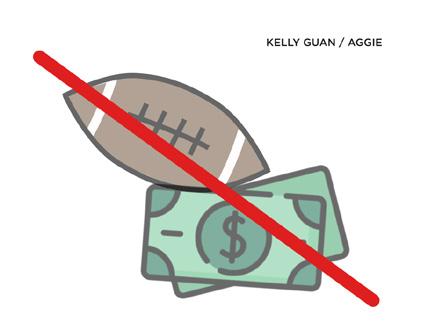




The city and campus community dedicate mental health forum and bench memorial to Najm
BY EMMA CONDIT AND CHRIS PONCE city@theaggie.orgOn Monday, April 29, shortly after the one-year anniversary of last spring’s stabbings — which left two dead and one severely injured — friends, family and other members of the Davis community gathered in Sycamore Park to discuss mental health and commemorate the life of Karim Abou Najm.
Karim was a fourth-year computer science major set to graduate last spring. On April 29, 2023, he was the victim of the second fatal stabbing which occurred at Sycamore Park, the same place this year’s memorial was held.
Karim’s father, Majdi About Najm, who is an associate professor of soil biophysics at UC Davis, reflected on the past year.
“We all lost someone dear on April 29,” Majdi said. “In about an hour, it will have been one year. To me and to many here, time stopped at that moment. Is it one year? At least that’s what the calendar says.”
The city dedicated a bench memorial to Karim, named a bike path after him and announced an art piece to be made next to the bench. The UC Davis Marching Band played some of Karim’s favorite songs in his honor, including “Imagine” by John Lennon.
The group stood around the site where Karim was stabbed last year. A plaque on the bench reads words written by Nadine Yehya, Karim’s mother.
“May the trees whisper his name and the birds sing his glory,” the plaque reads. “May the stars shine his light and the hearts carry his story.”
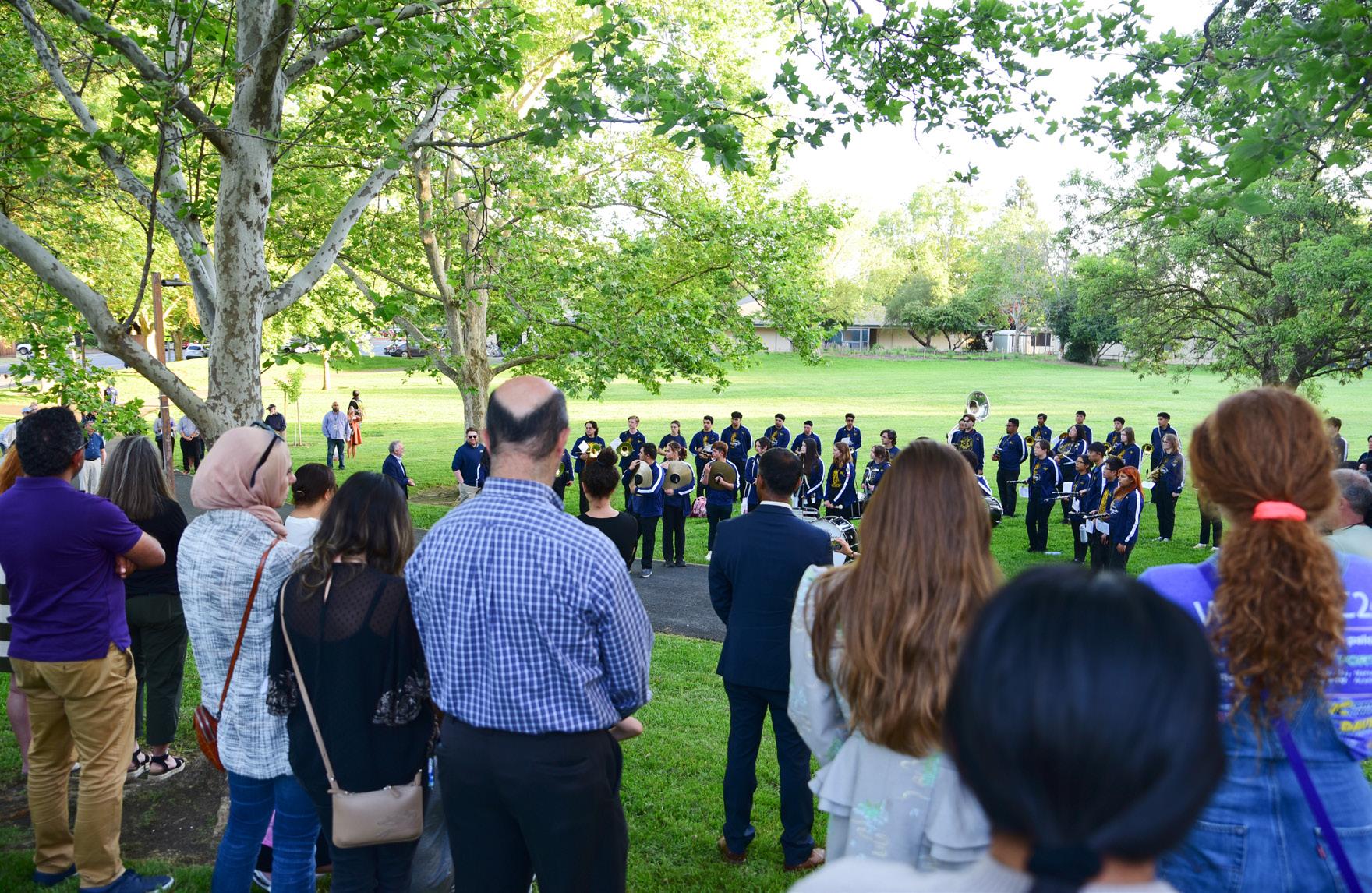
Mary Croughan, UC Davis provost and executive vice chancellor, attended the event and spoke about Karim.
“Karim’s future was full of possibilities, and the positivity that he shared with others thanks to his very generous and very kind heart could have continued to make this world a better place,” Croughan said. “Losing someone like that leaves a hole in all our hearts and in the future of our community.”
The evening also featured a discussion about mental health and the collective trauma that has been faced
over the last year. The event titled “Let’s Talk: Mind Matters” was meant to open a dialogue about mental health.
Dr. Andrés Sciolla, a professor of psychiatry at UC Davis Health and the keynote speaker of the event, offered guidance about ways to seek help.
“Resources are never enough,” Sciolla said. “Scarcity is the name of the game [...] Seeking professional help can be very important. We know now that traumatic events benefit from early intervention. Any kind of community can show support.”
Danzantes Del Alma’s 45th annual show celebrates the vibrancy and diversity of Mexican culture
UC Davis’ folklórico group serves as a home away from home for many students
BY LAILA AZHAR features@theaggie.orgA week before Danzantes Del Alma’s annual show, Michelle Mendoza, a fourth-year design and communications double major and the group’s publicity chair, described the energy that went into the production of the show.
“We’ve had our moments of stress and overwhelmedness and chaos,” Mendoza said. “It’s all been there, but I’m finally at peace. I’m ready for it all to come together and to see the excitement on everyone’s faces.”
When the group took the Mondavi Center’s stage on April 27, the production was a vibrant display of the members’ dedication and passion, and just as Mendoza had predicted, the excitement was palpable.
The production showcased music and dance from a variety of regions in Mexico, from Chiapas to Yucatán to Veracruz. Before each group of performers took the stage, introductions for each region were made in both Spanish and English.
Each group of dancers took the stage with wide smiles and colorful

costumes. The crowd was full of energy, as people clapped and cheered along with the music. When the curtain closed in between performances, audience members called out the names of their friends and family members in the show.
This year marked Danzantes Del Alma’s 45th annual show. The group, which is a student retention program housed under the Cross Cultural
Center, has been a part of the UC Davis campus since 1977. The club is officially a folklórico troupe, a term that encompasses a variety of traditional Mexican dances. However, their impact goes beyond the stage.
DANZANTES on 11
The “Let’s Talk” segment of the memorial was organized by the work of Sciolla and three undergraduate students: third-year chemistry major Jude Haidar, third-year human biology major Hailey Rosales and third-year psychology major Sydney McCan.
“We started the event just to kind of raise awareness about mental health with [Sciolla] as a psychiatrist and speaker, and then kind of evolved into honoring Karim since the day that we’re hosting them as on April 29,” Haidar said. “So we will be honoring Karim,
who unfortunately passed away that day last year.”
While none of these students knew Karim personally, they met with his family to discuss the event prior and how to respect his memory. Haidar shared that he and Karim are both Lebanese, which made his passing all the more personal.
“We are both Lebanese,” Haidar said. “On campus, I have not met a lot of Lebanese students myself. So to know that someone from your culture and ethnicity, unfortunately, passed away due to those circumstances, it’s kind of like they’re almost a brother to you in some way.”
McCan shared how it felt to meet Karim’s family and that she is glad there is work being done to help honor his legacy.
“It’s more personal when you get to know them,” McCan said. “It’s not just some story. And, I don’t know, at least for me, it was really heartwarming to see everything that’s being done to honor their son.”
Rosasles hopes that the event inspired people to look out for each other’s mental health.
“Encourage supporting one another, and if you see a friend or someone who is struggling, offer them help or seek other resources for them or yourself too,” Rosales said.
Vice Mayor Bapu Vaitla shared his gratitude for the memorial.
“I’m glad for this sign,” Vaitla said. “I know it’s just paint and steel, but it’s also a reminder of Karim’s joy. We share what we learn in the hopes that no one else will have to experience this sort of profound loss.”
This election had a 23.7% voter turnout and The Green Initiative Fund passed with 87.9% approval
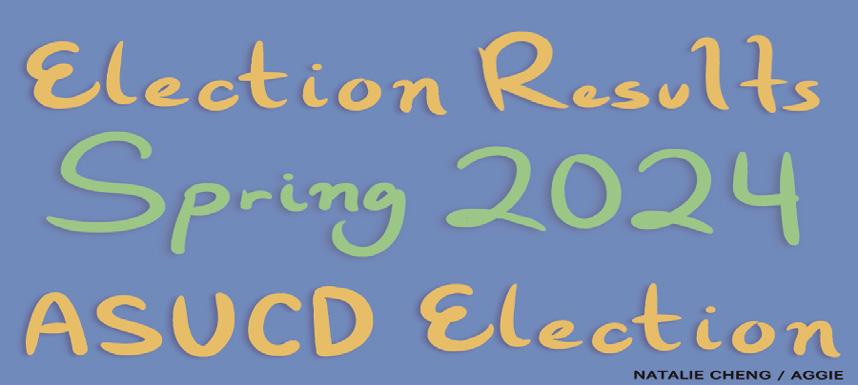 BY SYDNEY AMESOY campus@theaggie.org
BY SYDNEY AMESOY campus@theaggie.org
The results of the ASUCD spring election have officially been released on the ASUCD website. For the ASUCD executive ticket, Gaius Ilupeju (for President) and Aaminah Mohammad (for Internal Vice President) won under the Forward slate.
The External Affairs Vice President position was filled by Zephyr Schnelbach, who ran under the Forward slate as well. Six new senators have been elected: Dhilena Wickramasinghe with the “Bitch” slate Amrita Julka with the “Bitch” slate Mia Cohen with the “Empower” slate Asif Raiyan Ahmed with the “Forward” slate
Audrey Jacobs was elected Student Advocate. They ran as an independent. Muhammad Rafay Waqar was elected the International Student Representative, running with the Forward slate. Safa Mohammad was elected Transfer Student Representative, also running under the Forward slate. Both measures on the ballot, Constitutional Amendment #89, which introduces an official measurement of accountability to the ASUCD code of ethics, and The Green Initiative Fund (TGIF), which reinstates a student fee that pays toward student-led sustainability projects, passed. Notably, TGIF, which has been on previous ballots, passed with over a 20% turnout, meeting the threshold required to make its passing valid.
Researchers at UC Davis have discovered these fish through the use of genetic testing
BY MARLE LAMOUNTRY science@theaggie.orgDo you love fish? Well, we do!
Researchers at the UC Davis Fish and Wildlife Department have discovered new species of lamprey fish through the use of genetic testing. If you’re unfamiliar with lampreys, these jawless creatures have suctionbased feeding and vampire-like
features, including a diet consisting of blood from nearby fish. They also have prominent migratory behaviors and have often been overlooked in research — until now. Researchers at the UC Davis Genomic Variation Lab stumbled upon the fish with the help of Pascale Goertler of the Delta Stewardship Council. Researchers in the lab, including Grace Auringer, a UC Davis graduate student, used mitochondrial
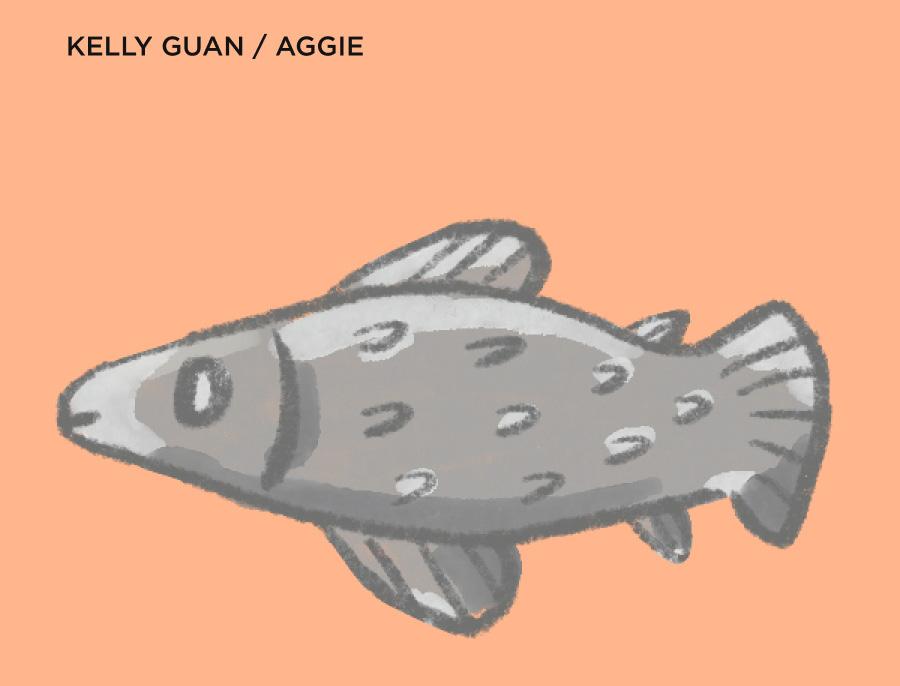
gene analysis to study their unique inheritance patterns. These patterns helped differentiate the two groups of fish from other populations along the west coast.
The gene of interest is mitochondrial cytochrome b, which researchers sequenced to find diversity.
“Lamprey individuals (N 87) from 19 sites in the Sacramento–San Joaquin River basin, San Francisco Bay, and Klamath River basin were sequenced for the mitochondrial cytochrome b (cyt b) gene, and the data were combined with publicly available lamprey cyt b sequences for analysis,” the study reads.
The two new species were discovered in the Napa River and Alameda Creek, near the Bay Area. Auringer was surprised by this, as the lampreys managed to swim unnoticed beneath a widely populated area and remained completely concealed until their discovery.
“Lampreys are understudied, and I wish I had references to understand the patterns I was seeing,” Auringer
said. “After colonization, certain fish were considered pests or ‘trash fish.’ Lampreys look like eels and have scary mouths. People judge a fish by its cover and call it bad.” Lampreys are viewed as a delicacy in some parts of the world — namely in England, Nordic countries and certain areas with Indigenous populations in North America. In California, lampreys hold a significant historical presence, once serving as a vital food source for indigenous communities as one of their earliest cultural staples. However, these fish populations are now facing a decline. The scarcity of recorded data on lampreys is a global phenomenon. These ancient creatures have roamed in Earth’s waters for over 300 million years, outlasting the dinosaurs, yet their populations are currently dwindling. Their story reflects narratives seen worldwide, highlighting the urgent need for human stewardship to restore lamprey habitats.

Dignity Health recently reached an agreement with Aetna in response to an expired contract
BY OLIVIA HOKR city@theaggie.orgDignity Health recently announced that they reached a multi-year agreement that will help return healthcare services for the 16,000 Yolo County residents who lost access to their providers over a contract expiration.
“Dignity Health is pleased to announce we have reached a new multiyear agreement with Aetna that will allow patients in California, Arizona and Nevada to maintain in-network access to Dignity Health hospitals, physicians, ambulatory surgery centers, and ancillary providers,” the group said in a press release.
On March 31, the contract between Dignity Health and Partnership HealthPlan expired after failed ongoing contract negotiations, resulting in thousands of Yolo County citizens without access to their essential healthcare services.
Partnership is a nonprofit healthcare organization that provides over 900,000 low-income communities in Northern California with Medi-Cal benefits through government funding. After the initial expiry, Partnership released a statement to ensure citizens that they were working toward an agreement.
On April 9, the Yolo County Board of Supervisors meeting agenda included an update on the impacts the negotiations had on residents.
Nolan Sullivan, a Partnership board member and director of the Health and Human Services Agency, presented information regarding the standstill between Dignity Health and Partnership. Staff on both sides worked diligently every single day, according to Sullivan. However, he also explained the problems that occurred between the two organizations.
“Both groups have a pretty strong vested interest to make a deal,” Sullivan said at the meeting. “The problem, frankly, is sort of twofold. The first is that Partnership is reimbursed by [the California Department of Health Care Services] to pay Medi-Cal rates and they have a cap, so Partnership can only go so
high without going into a net loss […] Dignity is trying to cover their cost, and to some extent they are trying to get [profits] out of the deal. So they’re both sort of stonewalling each other.”
Chief Health Services Officer of Partnership Katherine Barresi shared that the disagreements were in regards to costs that Partnership cannot afford, according to KCRA.
“As a Medi-Cal managed care plan, all funds come from the government,”
Partnership said in a press release.
“Payments to providers depend on revenue from the state and the plan cannot rely on lucrative corporate contracts like commercial health insurance.”
The contract complications have resulted in canceled doctor’s appointments and discontinued care services. Without access to Dignity Health services and facilities, residents have had to find new primary physicians and new treatment centers. Partnership clarified that in some cases, they may be able to make arrangements for patients.
“Partnership may be able to arrange for some members in the middle of care to continue to see their current [Dignity Health] doctor until treatment is completed,” Partnership said. “This may include care for acute conditions, cancer treatment, pregnancy, and some serious chronic conditions.”
At the Board of Supervisors meeting, Supervisor Jim Provenza of District 4 stressed his concern for the impacted Yolo County citizens’ ability to find new care. Not only is Provenza concerned about the urgency of citizen’s healthcare needs, but he is also concerned with the competition of the thousands who are looking for new doctors.
“Some of these people are sick, very sick — some are alone,” Provenza said at the meeting. “So you’re alone, you’re sick, you’re losing your doctor and you’re competing against 17,000 other people. How in the world do you find a doctor under those circumstances?”
Jonathan Raven, former chief deputy district attorney of Yolo County, spoke up during public comment to express his disappointment in the two organizations’ failing efforts. In
his years of involvement with Yolo County, Raven became close with his constituents, deepening his worries for the vulnerable citizens being impacted.
“I’ve worked with this population extensively in our collaborative courts and know families who have loved ones impacted,” Raven said. “Can you imagine someone who lives with psychosis getting a letter saying they have to get new doctors? That person then has to navigate this challenging terrain and part with doctors who have been treating them and find new doctors.”
Throughout negotiations, Dignity Health and Partnership were discussing a new contract to ensure that citizens would receive the care and services they need.
“Partnership is committed to continuing to negotiate in good faith with Dignity to reach an agreement soon,” Partnership said. “Dignity has been a valuable partner and Partnership looks forward to having them as a part of the network again.”
The Yolo County Board of Supervisors shared a press release to emphasize their stance on the issue and encourage a successful resolution for the safety of their communities.
“Both parties must recognize their shared responsibility to uphold the wellbeing of the population they serve,” the press release reads. “By working collaboratively and in good faith, we can find solutions that meet the needs of both Partnership HealthPlan and Dignity Health while ensuring uninterrupted access to healthcare services for our most vulnerable residents.”
Dignity Health shared how this new agreement with Aetna will impact the lives of their patients.
“This is a win for our patients who deserve access to high quality, high-value health care services close to home, and we appreciate their patience as we have worked through this process,” Dignity Health said in their press release. “We sincerely appreciate our patients’ understanding during the negotiations.”

Davis Sunrise Rotary Club gave audiences a rare opportunity to watch the first episode of ‘Climate Restorers’ before the release of the full series
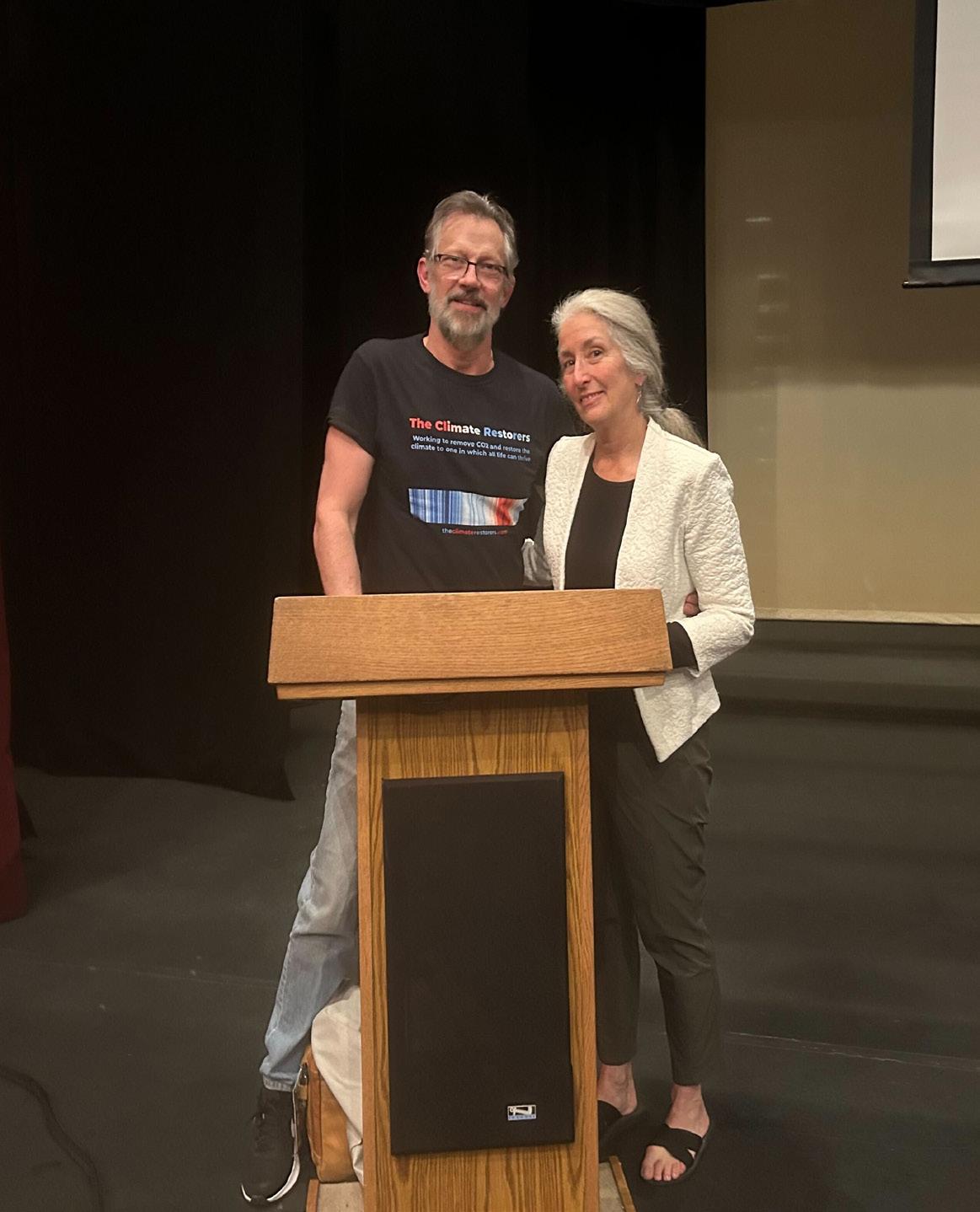 BY MATTHEW MCELDOWNEY city@theaggie.org
BY MATTHEW MCELDOWNEY city@theaggie.org
On April 24, The Environmental Committee of the Davis Sunrise Rotary club hosted a screening for the first part of an expected four part documentary series “Climate Restorers,” directed by John Bowey and co-produced by Phoebe Barnard, Ph.D. The film series strives to not only educate people about the gravity of the ongoing climate crisis but also shifts this narrative to highlight the real possibility of healing the damage done to our atmosphere, ecosystems and communities. Its first episode titled, “The Only Way to Predict the Future is to Create it,” focused on counteracting the potent greenhouse gas, methane.
The Davis Sunrise Rotary Club hosted this screening as a part of the nonprofit’s larger work around climate action and community service. Rotary, an international nonprofit service organization, coordinates acts of service to ensure more communities have things such as access to safe drinking water, healthcare for mothers and a cleaner environment. Frances McChesney, a chair member of the environmental committee, helps to ensure that the organization’s volunteers act and serve within the budget of the club, that they are in compliance with the bylaws of the organization as well as any directives or legislation at the federal, state and local level. As the chair, McChesney has been a part of the environmental committee’s projects to restore natural wildlife around Putah Creek, funding a coral restoration project in Panama, advocating for environmentally conscious concrete and reducing plastic use.
“One important thing for the environmental committee is that we continue to be a leader and help educate other clubs and people about how to protect the environment: avoiding single-use plastics, minimizing this impact where we can and the Rotary mission itself of service above self,” McChesney said. Having done her own share of
work on climate restoration projects, including but not limited to the use of iron fertilization to promote ocean biodiversity, McChesney was excited to help host the screening of the film.
The film was created on a small team and a thin budget, the “Climate Restorers” brings together a wide range of scientists and experts within the climate restoration field for the first time in documentary form according to Bowey. Addressing himself to the audience before the screening, Bowey emphasizes the importance of a climate conscious mindset.
“Too many people think of climate change as something purely subtractive,” Bowey said.
“It makes people believe that they have to cut this and cut that, but that is not always the case.”
In short, Bowey feels that climate solutions could pave the way to new industries and introduce new and higher quality products to consumers. The hardest hurdle to this is that change itself is uncomfortable, but at the very least it does not have to be uncertain. The co-producer, Barnard, is an American global change scientist and a professor of conservation biology and environmental futures at the University of Washington. As co-producer, Barnard was concerned with much of the complicated science behind the film process, and thanks to her experience in policy and education, she felt very impassioned about making real changes through climate advocacy.
Concerned by the unsustainability and lack of mobilization against the issue of climate change, she hopes that the film helps educate people on these issues, but more importantly, she hopes it is able to motivate people rather than discourage them.
“The world really doesn’t have to be this way, and it certainly doesn’t have to end this way,” Barnard said.
“But we have to understand now that we are at a certain crossroads for our civilization, and we have to take back our agency to shape our future.”
City of Davis receives $24 million to improve roadways, install new ‘Cool Pavement’
Davis receives the largest grant in city history to improve roadways and mitigate the effects of extreme heat
BY HANNAH SCHRADER city@theaggie.orgThe city of Davis recently received a $24 million grant to install new “Cool Pavement,” which is lighter in hue and has an average temperature of 10 to 12 degrees Fahrenheit cooler than traditional asphalt during the afternoon hours.
Congressperson Mike Thompson described the scope of the bipartisan infrastructure law, which was recently passed in the House of Representatives.
“The bipartisan infrastructure bill represents the largest investment into our infrastructure since the Eisenhower administration,” Thompson said. “There’s a lot of things that we need, everything from rebuilding our bridges to electrical grids. This bill covered a lot
of different areas.” Thompson put out a press release on April 8 in which Davis City Manager Mike Webb commented on the infrastructure grant.
“We are very thankful to be awarded this $24 million grant — the largest ever received in the City of Davis history,” Webb said in the press release. “These funds will go towards the Davis Cool Pavement Project, which addresses the imminent threat of extreme heat through effective changes in pavement, applying the best practices in solar reflective, or ‘cool,’ pavements. This Project will repave 15 different roadway segments in Davis that are failing and help bring them up to current progressive City striping standards, helping us achieve our ambitious goals around climate adaptation, street design
and bicycle planning.” Thompson then spoke on his role in voting “Yes” on this infrastructure bill.
“My ‘Yes’ vote on this was reflective of the need for this investment,” Thompson said. “Which is everything from better roads so people don’t have to destroy their cars going back and forth from work to relieving congestion, which adds to stoppage in our supply chains [and causes] more climate change problems. I recognize that we’ve got to spend money to do this stuff [...] this was a good bill. It will create jobs [and] make our transportation better for the environment, so it was a ‘Yes.’” Thompson continued on his efforts to combat climate change at large.
“I believe that climate change is the biggest issue that we face as people. We can get everything else right but if
we mess up on climate change, it will be for naught,” he said. “I worked on this for a long time for the Inflation Reduction Act. They included my legislation in the Green Act, which accelerated our move into renewable energy [...] the government is going to have to participate, play a role and make it easy for consumers to participate in this effort to make it easier for them to get into renewable energy.” Ryan Chapman, the assistant director of public works engineering and a transportation/traffic engineer for the city of Davis, then spoke on what the city is doing to reduce the effects this project will have on traffic.
“Staff will work on a design that includes construction phasing and traffic handling that will break the paving into smaller segments to reduce
traffic impacts,” Chapman said. “Staff will also coordinate with utilities, other capital improvement projects, private development projects and permit work to reduce conflicts.”
Chapman then talked about the possible timeline of this upcoming infrastructure project.
“The 15 project segments will be delivered in phases over five subsequent construction seasons as weather permits,” Chapman said. “The order/sequencing of streets is to be determined at this point. Some streets will require utility coordination or other improvements as a result of the paving. Projects will also need to be coordinated with other construction maintenance and improvement projects.”
Unitrans representative also discusses potential collaboration between different ASUCD units and the buses
BY JORDAN POLTORAK campus@theaggie.orgThe April 25 meeting was called to order at 6:23 p.m. by Vice President Aarushi Raghunathan following a roll call and land acknowledgment.
Senators Jacob Klein and Gabriel Gaysinsky presented a training on antisemitism to the Senate. The presentation was broken into three segments which included explaining Jewish identity, defining antisemitism and addressing common misconceptions regarding antisemitism.
“[Antisemitism is] a certain perception of Jews, which may be expressed as hatred towards Jews,” Gaysinsky said. “Jews make up only three percent of California’s population but make up 8.6% of hate crimes. Nationwide, Jewish people are two percent of the population yet are the target of 60 percent of religious hate crimes.”
Gaysinsky asked for examples of left-wing and right-wing antisemitism.
“In the spaces I’m in, as a left-wing person, I have to educate people on left-wing antisemitism, because there is so much misinformation about Israel and Palestine,” Senator Yara Kaadan said.
“People unknowingly engage in antisemitic rhetoric. People across the political spectrum are not immune to bigotry including antisemitism.”
Gaysinsky then discussed misconceptions regarding antisemitism.
“[It is] uniquely pervasive, because it is seen as punching up and punching down at the same time,” Gaysinsky said. “We are seen as both oppressors of nonwhite people as an entire community and also diluting and replacing the white race at the same time. If you’re confused, good, so am I.”
“Not everything about an entire
community can fit in 20 slides,” Klein said. “This is meant to serve as a continuous dialogue, and we are always open to talk about this.”
External Affairs Vice President Celene Aridin then read public comments regarding budget concerns and criticism of lack of transfer student representation in the Senate.
Senator Dani Antonio responded.
“The OTSR [Office of the Transfer Student Representative] is doing valuable work,” Antonio said. “They have been planning events, reaching out to transfers and lobbying. Transfers do see it. In terms of representation, the OTSR has hosted events surrounding that, to get more people on the table who are transfers to have that representation.”
Then, ASUCD Elections Officer Sriya Batchu made an announcement that the election turnout was 17.3% at the time of the meeting.
“These are the highest numbers since COVID,” Batchu said. “I would love to get the numbers as high as we can — help us end off strong.”
Next, Jonah Messinger, the advertising sales representative for Unitrans, presented his proposal for a “Moo-vin Moo-seum.” The bus chosen for this would feature a bus wrap advertising ASUCD and the artwork inside the bus.
“The possibilities are unlimited for this project,” Messinger said. “All of the growth and expansion of this project will be tied to ASUCD. It directly engages students and people are going to want to be engaged. The Unitrans buses provide high visibility for ASUCD to show what they provide for the Davis community.” Aridin responded.
SENATE23 on 11
Ojeda reflects on his year as he ends a tenure marked by heavily covered impeachments and setbacks
BY VINCE BASADA campus@theaggie.orgASUCD President Francisco Ojeda’s year-long term has been nothing if not historic. The third-year political science and Spanish double major made history as the first AB540 President of the association and the first to be impeached by the Senate, who accused him of failing to carry out his constitutional duties. Ojeda announced during his State of the Association speech on April 4 that he would not be running for reelection and would leave ASUCD at the end of his term and the current academic year. He agreed to sit down with The Aggie to talk about his administration, what he’s learned and what’s next.
Below is a transcript of Ojeda’s interview with The Aggie that has been edited for length and clarity.
Q: So, how are you feeling today? How are budget hearings going? How’s the association today?
Ojeda: It’s good. It has been a long wait for many people to see the budget, and it has taken us a lot of time but, thankfully, has been able to be released before the deadline. I served as [a] senator during the last budget hearing, and that was heavy and [required] long days [...] we’re hoping this is easier on everyone.
Q: Let’s talk about your term as a whole. Have you been reflecting a lot?
Ojeda: Definitely. I feel like there’s some small conversations with people, with friends, that have made me think of my year more with the election this time around. It has been a year since I was out there in the quad, in the Silo, talking to students about my goals and putting myself out there. It has been a crazy and wild year in all aspects. I don’t want to sound egotistical, but there has been so much stuff happening. We had an Opportunity for All crash and the regents postponed that. We are able to accept [undocumented students], but
we are not able to give them work. That was one of the unfortunate things.
Q: How do you feel your term went as a whole? I mean, it’s not over just yet, but you’re getting close to the end.
Ojeda: What, five, six more weeks? It was crazy at this point [during] week four [of] last quarter. It was stressful. I’m not gonna shy away from mentioning the impeachment. It stopped me from doing my work, and I’ll admit to that.
Q: During the impeachment, could you talk about specific things that you weren’t able to do?
Ojeda : Progress got stopped. I just felt like managing this whole position is already hard, but when you have to defend your position and also keep doing this work, I do believe it hinders my progress. I would like to apologize to the students for that particular time period [when] I wasn’t at my best. It’s like, damn, I finally get what this position demands from me, but I’m about to term out, you know? It’s definitely bittersweet the way you have all these skills, but you’re terming out, and it is what it is. You have conversations with the chancellor and different stakeholders; you need to know how to do it. And when I came [into power] in September and during the summer, I didn’t know that. I learned that along the way.
Q: Now that you’re kind of closing out this term, you feel like you’re getting the grasp of it, getting the hang of it. So why not run for reelection and keep going?
Ojeda: Well, although I have done things that haven’t been done, like being the first AB540 ASUCD president or other stuff, I’m a person too. I’m an individual person. And although some people have forgotten about that during this year, [I’m] looking [to go] into my [fourth-]year more relaxed. Like I said, this is a very demanding position. I do not envy any student government president. But, every time I was doing my work, every time I was starting a project, I wasn’t thinking about setting
up any political reelection. I feel like it is very healthy for me to understand that. I had a year. I believe I accomplished things I wanted to accomplish.
Q : You mentioned that you accomplished some things that you were planning to and you accomplished some things along the way that you weren’t expecting. Could you be more specific?
Ojeda: The budget is one of the unexpected things. I hope [that] after budget hearings, the units and all the ASUCD bodies are able to say that they feel well set up for next year. And that’s one of the things I was surprised about. We always talk about how there’s no money around, and I was surprised that out of first impressions, people seem pleased about their budget. [Something] that were always on [my] watch was The Pantry’s transition to what was formerly known as Gunrock Gaming. There’s a bigger premiere lounge coming up which we hope to have balloons and stuff. I don’t know if it’s gonna be under my term or for the next president in fall.
Q: You mentioned the upcoming ASUCD president. By default, it will be Gaius Ilupeju. What are some messages of advice you have?
Ojeda: First of all, I know Gaius. He served as senator way before I came into Senate. I feel like ASUCD and the UC Davis students are going to be happy with his work. He knows ASUCD. I have some more advice for him that I’ll share with him privately, but I think he’s well set up. I have no doubt he’ll do an amazing job. I have a lot of faith in him and what he represents.
Q: This is kind of taking a step back a little bit, but looking at ASUCD as a whole, what do you think it can improve on? What do you think are its biggest failures and weaknesses?
Ojeda : Let’s start with the downsides. Outreach is something we don’t seem to get right. I feel like this academic year we have slightly improved, and I hope this election reflects it.
PRESIDENTREVIEW on 11
Two UC Davis students discuss their unique ASUCD Senate campaign
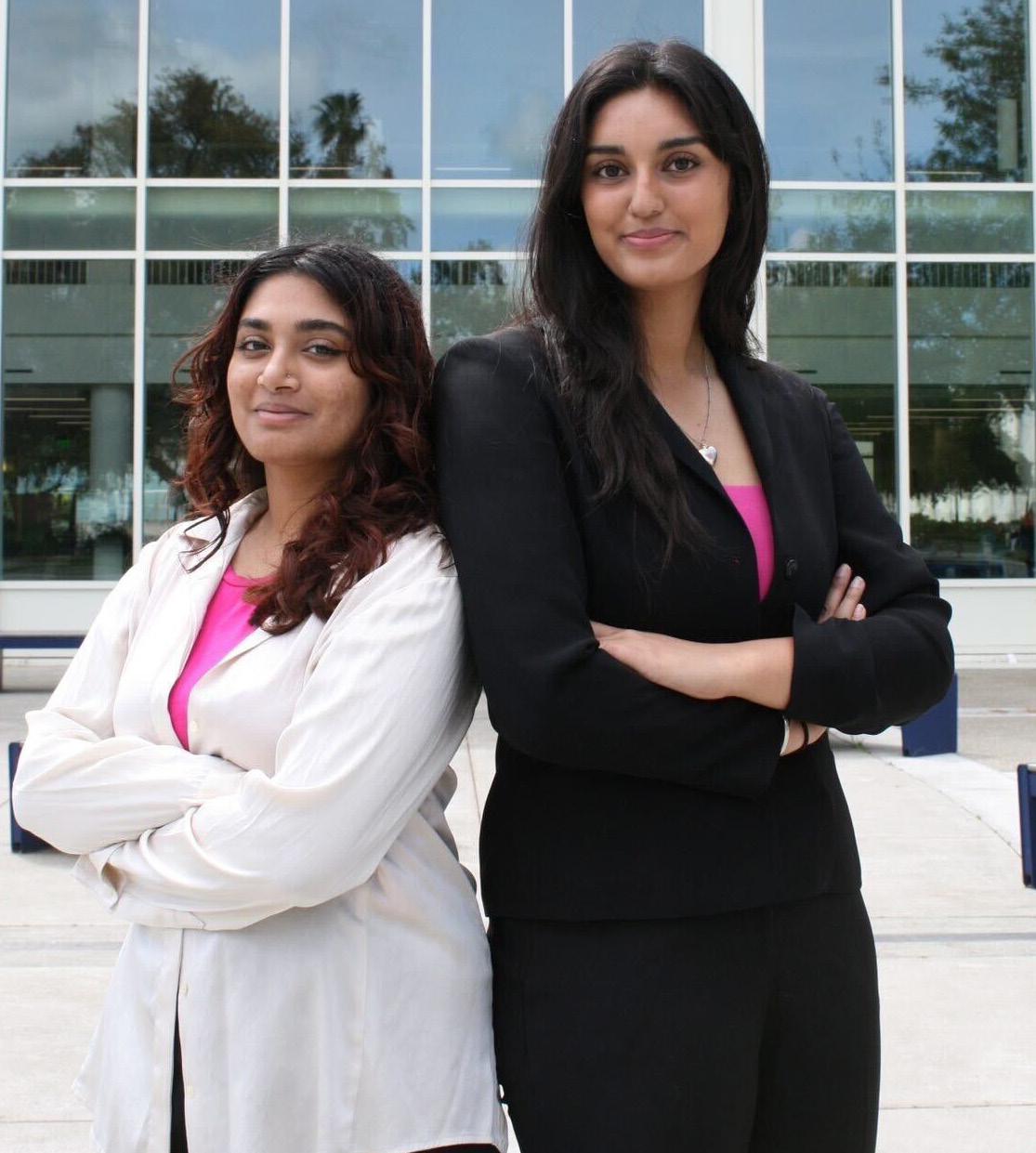 BY EMME DUNNING features@theaggie.org
BY EMME DUNNING features@theaggie.org
Chances are, if you’re a woman, you’ve been called a bitch at some point in your life. The term is an all too common insult, often taking aim at women who hold leadership roles.
Dhilena Wickramasinghe, a secondyear sociology major, and Amrita Julka, a first-year political science major, are embracing their identities as bitches. The pair ran for open spots in the ASUCD Senate, under a slate poignantly titled, ‘Bitch.’ As prominent women in student government, Wickramasinghe and Julka have personal experiences with the struggles associated with being women in leadership.
“Women are constantly called bitches for advocating for themselves, for standing up for what is right and just trying to seek higher positions of power in general,” Wickramasinghe saidtold The Aggie. “Naming our slate ‘Bitch’ is kind of a punch back.
We’re women, we’re proud to be women and we are reclaiming the power that is trying to be taken from us when men call us that word.”
Although supporting women holding positions of power is a priority for the pair, Wickramasinghe’s slate partner
One potential solution, the ASUCD Fair, will address the lack of connection between students and ASUCD
BY RODRIGO VILLEGAScampus @theaggie.org
At the April 11 Senate meeting, Iris Chen, the Academic Affairs Commission (AAC) vice chair, proposed an ASUCD Fair for fall 2024. The fair, if approved, would be an open event at the Memorial Union (MU) Quad where students can gain exposure to ASUCD and the resources they provide. This event would address one of the most critical complaints students have regarding the association: lack of connection. In turn, this will help improve the association’s reputation. ASUCD provides several resources and services aimed at improving the quality of campus life, such as Unitrans, legal services and Lawntopia. Yet, according to Chen, many students either feel disconnected from ASUCD or don’t know that it encompasses more than just The Pantry and the CoHo, a sentiment held among students for years.
“They don’t know that [there are] so many committees under it and what they do,” Chen said. “Even when students know, they probably either just know about the drama from Reddit, or they just know the big names like Unitrans and the CoHo.” Britney Cao, the AAC chair, elaborated on Chen’s thoughts.
“I think a lot of students don’t know what ASUCD is in general,” Cao said.
“A lot of students just don’t know the name, and it’s not like we’re doing a lot to promote [ASUCD] either.”
Cao clarified that although individual units host events or offer resources, ASUCD is typically not explicitly attached to these events or resources. Consequently, it becomes difficult for the name to stick with students.
“It’s difficult, because when, say, AAC hosts events and workshops, we’re promoting our name,” Cao said.
“We’re promoting our commission solely, under ASUCD obviously, but we’re not actively promoting ASUCD as a whole.”
Chen said she’s had this idea in mind since last fall, when she was confirmed as the AAC vice chair.
However, she started developing the idea during spring break.
The event would be a tabling event similar to the Center for Student Involvement Fair, Whole Earth Festival and many others. Each participating unit would have their own table to promote both themselves and their services. Furthermore, brochures would be distributed to students that would include a map of the fair, general information about ASUCD and upcoming events and opportunities.
Gaius Ilupeju, the incoming ASUCD president, attributed the lack of connection to two factors, one of which is a perception problem.
“The idea that the Senate is a bunch of political science or pre-law students that have nothing better to do but roleplay politics has passed down over time, and that is how people have come to perceive the student government,” Ilupeju said.
The second factor, he said, is a structural issue that has decreased the association’s engagement with the student body.
“A lot of people that have come into ASUCD in the past have not done their best to increase engagement,” Ilupeju said. “Over time, that has snowballed to the point where when new Senate tables come in, they have a massive issue to deal with regarding engagement. However, they choose to focus on what they came to do as appointed officials and neglect engagement.”
Ilupeju mentioned that he has four different ideas to close the gap between the association and the student body: first, improve the internal cohesion within ASUCD; second, ensure elected officials show their faces by attending club meetings or tabling; third, change the format of how the student government reports to the public — the quarterly town halls — so it is more
Julka noted that this election is crucialparticularly important in terms of the need for adequate representation.
“[Our campaign] comes at a crucial time because all the women who are currently serving on the senate are leaving,” Julka said. Due to the small number of women r unning for Senate, Julka worries about the possibility of a Ssenate without representation for women, and the impacts this may have on ASUCD as a whole.
“There is a very high chance that women will not be represented fairly on the Senate table for next year.
That’s why we’re focusing so much on this women in charge, women empowerment move,” Julka said. Julka and Wickramasinghe both currently serve on committees within ASUCD, which they feel has helped strengthen their understanding of the campus’s needs andneeds of the campus, and has informed the priorities outlined in their campaigns.
Although they share a vision of making the ASUCD Senate more equitable overall, they also hold their own distinct views and priorities within their respective campaigns.
Wickramasinghe, a current member of the Sexual Assault Awareness and
Advocacy Committee, hopes to continue advocating for sexual health resources in a senatorial role. In their campaign statement, Wickramasinghe outlined initiatives supporting this goal, including increasing access to sexual health products in different locations around campus and ensuring sexual health education workshops are inclusive of the needs of the LGBTQ+ community. In addition, she hopes to advocate for diversity awareness and increase knowledge surrounding protections for student activists.
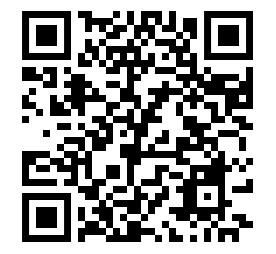
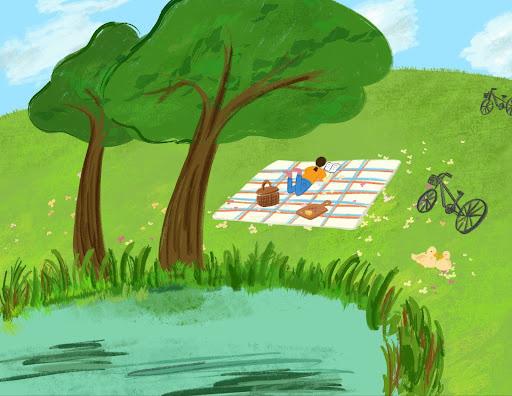
Disclaimer: (This cartoon is humor and/or satire, and its content is purely fictional. The story and names of “sources” are fictionalized.)
accessible to students and fourth, hire a full-time marketing director to advertise ASUCD. His third idea in particular echoed the same concept as the ASUCD Fair. “What we plan on doing is scrapping the idea of quarterly town halls and doing an association-wide quarterly showcase in the MU Quad,” Ilupeju said. “We’ll have tables set up for the different senators and units to bring students to us, so they can ask questions and see what the Senate is doing.” When asked about his thoughts on the ASUCD Fair, he acknowledged it as a great idea and as “more of what we need.” Chen’s personal motivation for the fair is for students to see the faces behind ASUCD so they are recognized and appreciated. She emphasized that a lot of units’ work occurs behind the scenes, so students don’t recognize the work of ASUCD members.
“A lot of work we do, we don’t do it to promote ourselves,” Chen said. “We do it because we really want student life to be better.”
Why do viewers seem to miss what “Dune” is really about?
BY JOAQUIN WATERS jwat@ucdavis.edu“Dune: Part Two” is only a month old, yet it may already be the movie of the year. The film has taken the entertainment industry by storm, leading many to declare the sci-fi franchise the next “Lord of the Rings” or “Star Wars.”
That comparison is appropriate in many ways. Like those other series, “Dune” is a visually groundbreaking epic with a huge pop culture footprint. But such a comparison has also led to mass misreadings of the latest film and its messages.
Search “Dune” on social media, and you will be bombarded by arguments about what both the film and the classic novel it is based on are really trying to say: is it a cliched white savior narrative or a biting critique of imperialism? Is it a morality tale about how a good person turns evil in the vein of “Star Wars: Revenge of the Sith” or an environmental stranger-ina-strange-land tale in the vein of James Cameron’s “Avatar?” Is it fascist? Is it “woke?” Well, the truth is a bit more complicated than that. Allow me to explain. (It goes without saying that spoilers follow for both the films and
One of us is a lethal weapon of mass destruction and the other is Godzilla
BY AUDREY ZHANG aurzhang@ucdavis.eduI know what you’re thinking. How can a stunning, six-foot-five, cancer-curing college bombshell ever compete with the one cool thing that came out of nuclear armageddon? She doesn’t have a chance. And you’d be right, because that woman isn’t me. I somehow managed to pull a muscle getting out of bed this morning, but I’d still be able to make Godzilla run crying back to his underwater home. Except he can’t, because we managed to blow that up too.
I’ve done the math and it will take me approximately 1954 million years of gym rat grinding in order to bulk up enough to punch Godzilla in the face. In the meantime, there are other options.
It is just a matter of using Professor Honda’s favorite tactic — psychological warfare. Even unholy creations spawned from mankind’s mistakes need to watch out for their mental health. I’d just need to remind Godzilla that no one loves him, he wouldn’t know a good essay if it slapped him in the face and that he’s a lonely orphan loner who’s alone. He will get no closure because there are no Godzilla therapists, because there aren’t even any other Godzillas. (Again, because he’s a lonely orphan loner who’s alone.) He will try to adopt cats so that at least someone will love him, and thus be too busy to squish any more cities. If that amazing plan fails, I simply have to post a photo of Godzilla, preferably next to a trademarked item. Then, I wait for Toho to find out and sue him into oblivion. They’ll sink anyone violating their beloved copyright so quickly, it will make the Oxygen Destroyer look like a nice bubble bath.
But let’s be real, I’m going to do none of these things. Godzilla is cool, way cooler than the people trying to bomb him for the millionth time. It didn’t work in the last 30 movies, it’s not going to work now. Next time he rises, I’m going to be asking for his autograph, and fighting on his side. You guys better watch out.
Disclaimer: (This article is humor and/or satire, and its content is purely fictional. The story and the names of “sources” are fictionalized.)
the novels.) “Dune” follows Paul Atreides, the young scion of an intergalactic Duke. After his family is murdered in a political plot, he becomes an outlaw and rises to become the messianic ruler of the desert planet Arrakis — and, since Arrakis is home to an all-important substance called “the spice” (think of it like a cross between marijuana and oil), the entire human race. Paul’s development is the fulcrum of the sprawling tale, and it has widely proven difficult to penetrate. Critics of the story point to Paul as a textbook example of the white savior trope: an imperialist colonizer who comes to a foreign land, ingratiates himself among the people (in “Dune,” this is the native “Fremen”) and leads them out of their perceived savagery into a brighter future. I have seen reviews of “Dune: Part Two” state that rather than Timothee Chalamet, the filmmakers should have cast an actor of color in the role to curb these perceived problematic undertones. But this is an immensely shallow reading of the story that goes no further than skindeep.
Paul, like Neo of “The Matrix” or Harry Potter of, well, “Harry Potter,” is an archetypal chosen one. The Fremen have prophecies foretelling a great leader who will lead them to paradise,
and Paul fits the mold. But unlike those previous examples, “Dune” makes it clear that this prophecy is not genuine but planted among the Fremen as a means of control. Paul foresees that should he take on the role of the savior, the Fremen will become religiously enslaved to him and genocide will follow. As a fundamentally good person, Paul resists this future for much of the narrative in favor of living a simple life among the Fremen. But ultimately, his desire for revenge against those who killed his family, along with the imperialist values he grew up with, surpass his love of the Fremen, and he gives in to the supposed “prophecy.”
There is a line in the novel that the recent films removed in which a character ominously warns a Fremen leader, “No more terrible disaster could befall your people than for them to fall into the hands of a Hero.” I have seen viewers of the film state that they do not understand why Paul’s ascendancy is a bad thing; after all, he kills the villains who have suppressed the Fremen for decades. But this is also a misreading: Paul may have “liberated” the Fremen from their current condition, but he has also enslaved them to his own cult. He does not break the corrupt system, he merely restructures it so that he sits at the top.

His victory against the evil emperor rings hollow because of what follows on its coattails: in the sequel novel “Dune Messiah” (which will allegedly form the spine of the upcoming third film), it is revealed that the holy war started in Paul’s name resulted in the deaths of billions of people. On this note, I have also noticed yet another misreading permeating the online discourse — that Paul’s descent into fascism is comparable to that of another famous sci-fi character, Anakin Skywalker of the “Star Wars” prequels. Once again, on a surface level, that comparison is understandable; both are morally compromised savior figures with long hair and swirly dark cloaks. But “Revenge of the Sith” (the film that depicts the heroic Anakin’s transformation into the villainous Darth Vader) depicts Anakin’s fall as being caused by dark forces pulling him away from his destiny. He becomes the villain by failing to live up to his prophecies. With Paul, it is quite the opposite; he becomes the villain precisely because he does fulfill his supposed destiny. He remains the hero of the story — but a hero can be a terrible thing.
The discourse around “Dune” was inevitable. Filmgoers (especially of the sci-fi/fantasy genre) have been conditioned to expect a certain kind of
story where good triumphs over evil, and a hero goes through a journey of self-discovery. “Dune” hits all of the familiar beats, yet viewers seem not to know what to do with his obviously wrong actions. Hence the debate: is the film endorsing Paul or condemning him? Is it about a hero who loses the way or a villain who finds it? But the truth is that it’s a far more complicated story than that, one that is not interested in questions of good and evil so much as freedom and control and the ways in which one blends into the other. Paul Atreides is a liberator and a tyrant, a colonizer and a refugee, an impassioned freedom fighter and an imperialist politician. These things may seem contradictory but often they are not: just look at real-world figures like T.E. Lawrence, Fidel Castro or Vladimir Lenin. So to understand “Dune,” do not try to pin down its politics. Let the unsettling ambiguity wash over you, and you will understand why it is so important.
Disclaimer: The views and opinions expressed by individual columnists belong to the columnists alone and do not necessarily indicate the views and opinions held by The California Aggie.
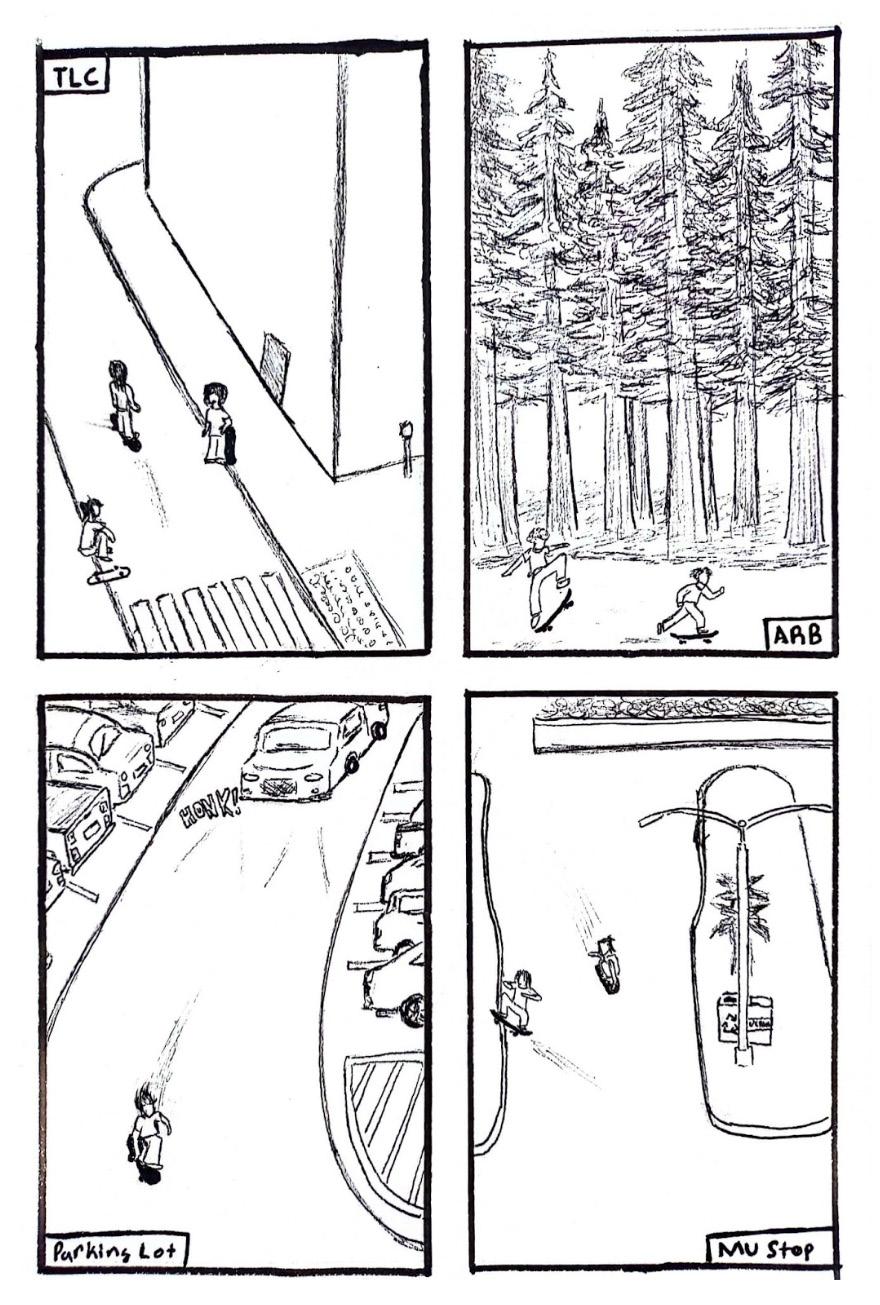
BY EMMA LAPIDUS eblapidus@ucdavis.edu
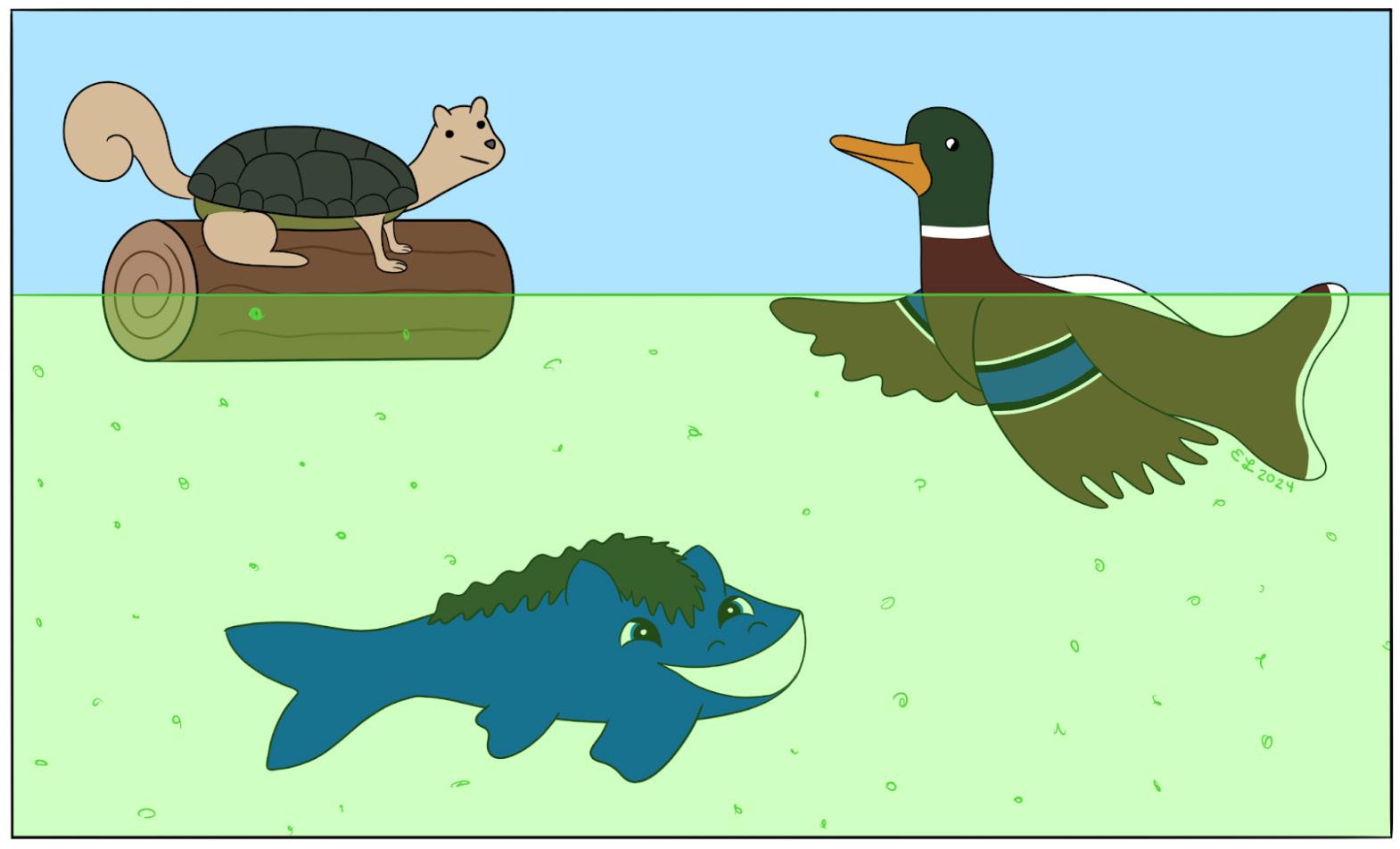
The Editorial Board urges administrators to pay attention to student voices as pro-Palestinian protests erupt across America
BY THE EDITORIAL BOARDIn recent weeks, protests have broken out on college campuses across the country calling for universities to take action in support of Palestine in response to the current conflict in the Middle East.
At the University of Southern California, an on-campus encampment formed after the university announced they would not allow their valedictorian — who has publicly supported Palestinians — to make a commencement speech. They later closed the campus to outside visitors and canceled their main commencement ceremony, although college-specific graduation ceremonies will go on as planned without the valedictory address.
A similar encampment is ongoing at Cal Poly Humboldt, where the campus is closed until May 10 due to protestors occupying and defacing the office of the campus president, as well as setting up dozens of tents around the hall, according to the New York Times.
UC Davis students have spoken up as well in response to the violence in Gaza. In February, urged by hundreds of students who showed up at the quarterly ASUCD Town Hall to speak during public comment, the ASUCD Senate passed Senate Bill (SB) #52, implementing an ASUCD boycott of and divestment from “corporations complicit in human rights violations against Palestinians.”
The Editorial Board believes that in a moment like this, when students feel passionate enough about an issue to do something about it, universities have an essential opportunity to remember and uplift the importance of free speech — even and especially when it’s controversial or inconvenient.
Do colleges legally have the ability
Scan to read our online editorial about Earth Day

to set rules in place and enforce those rules when it comes to destruction of property, or trespassing? Yes, and we understand why responding to these protests can be complicated. There might be some legitimate safety issues, concerns about the costs of vandalism and an unwillingness to interrupt education — especially when it’s already been interrupted so recently by the COVID-19 pandemic and a UC system-wide academic strike last fall.
But although there are legal boundaries, the First Amendment doesn’t say that we have freedom of speech except when it makes things complicated. In fact, the point of being a country that values free expression is precisely to make things complicated, or to have enough diversity of viewpoints that the complexity of a situation is revealed. Protests are inconvenient for a reason — that’s what makes people pay attention to the issues they’re fighting for.
If anything, colleges should be more of an advocate of free expression than almost anyone else. If university is meant to teach students how to think critically, how to form an opinion in complex situations and how to care deeply about the things going on in the world around them, students shouldn’t be punished for doing just that. There is an important distinction to be made. We recognize that not all of the protests have been peaceful.
Some universities cited acts of antisemitism as reason for increasing security or closing down their campus, whether it be harassment of Jewish students — at Columbia, students reported being shoved, spat upon and blocked from attending classes — or violent chants and slurs, from “Kill the Jews,” at Northeastern University to “Zionists don’t deserve to live” at Columbia.
All students should feel safe on their college campus, and attempting to reach peace overseas via spreading more violence and hatred locally is not a solution. But the fact is that many of these protests have been peaceful. Delegitimizing all students’ concerns and arguments regarding the ongoing violence based on the actions of some is a fallacy that fails to honor the nuanced thinking that is characteristic of an academic institution.
So what are students’ concerns?
What exactly do they want the outcomes of their protesting to be?
Some students are calling on their student governments and administration to divest from organizations that have financial connections to Israel, especially when
it comes to weapons manufacturing. Others are calling on their universities to entirely cut ties with Israel, including ceasing study abroad programs and ending academic collaboration with Israeli universities.
As mentioned above, ASUCD voted on a student government divestment months ago. However, the University of California at large put out a statement on April 26 opposing calls for a boycott against and divestment from Israel, saying that “a boycott of this sort impinges on the academic freedom of our students and faculty and the unfettered exchange of ideas on our campuses.” They also noted that UC tuition and fees are not used for investment purposes.
Some of the student activists’ goals might be more complicated than others. Divesting endowments can be difficult, especially because much of this funding is often used to provide financial aid and scholarships to students, meaning that divesting or refusing to accept donations from certain companies could have a direct unintended negative impact on students. But protests with this call have succeeded before; in July 1986, the UC Regents voted to divest more than $3 billion from companies doing business with South Africa’s apartheid government after more than a year of student protests.
Whether or not universities decide to divest from Israeli-tied companies, the continued calls from students for them to do so not only keep the conflict in the news, but also serve as a constant reminder of the fact that youth are aware of and engaged in conversation surrounding Israel and Palestine — an impact that shouldn’t be underestimated with it being an election year.
This isn’t the first time nationwide activism has spread across college campuses, and it won’t be the last. Regardless of what ends up happening at each of these schools, the administrations’ response to student protests matters. Are they going to take student concerns seriously? Are they going to negotiate and talk with student protestors in good faith?
College campuses in the United States are a microcosm of the divisive but passionate political activism on the rise in today’s youth. How each university chooses to facilitate or hinder that, regardless of how complex the issues at hand are, is going to be a part of those institutions’ legacy — whether they like it or not.
Video killed the radio star BY MOLLY THOMPSON
mmtthompson@ucdavis.edu
Our current media landscape revolves around a constant stream of content. There are more posts than a single person could ever keep up with — it would take over 18,000 years to watch every video currently uploaded on YouTube. The expectation of entertainment in the modern era is that it’s fed to us perpetually, which has changed the way that artists have to work. To keep up with our demands, they have to produce more rapidly.
Before streaming became the primary way to access music, movies, TV shows and other entertainment, the process of creating media followed a much slower timeline. TV episodes were released on a weekly schedule instead of all at once (granted that some programs do still follow that model) and musicians took longer recesses in between album releases (granted that some still do break for greater periods of time), which meant that consumers had to wait.
This served two major purposes. First, it allowed artists to revel in the creative process. A musician could spend multiple years developing a tracklist and could go away and marinate in their muses long enough to build a nuanced anthology. Now, artists are expected to churn out new records in succession — if they want to stay relevant, they don’t have the
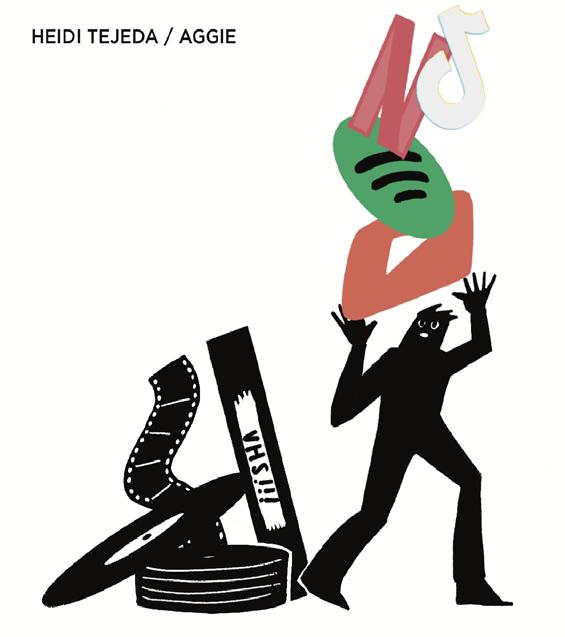
luxury of slowly creating a collection of songs. This is due, in part, to social media and how vlog-style content has become so mainstream. It’s normal for us to see creators releasing videos every single day on YouTube or even multiple times a day on short-form platforms like TikTok. We’ve become conditioned to expect content that’s released quickly and frequently, and the internet is so saturated, that we can move on and find something else to devote our attention to if we’re not getting that from a creator. Additionally, vlog-style content is relatively simple to produce. It doesn’t require the same level of meticulous construction that traditional media (i.e., movies and TV shows) does, which means that its value isn’t lessened by rapid production. Where this becomes an issue, though, is when we apply those expectations to traditional media — great works of art can’t be created without time.
Vlog-style content serves its own purpose. This is not to say that it’s not valuable, but equating it to more involved mediums of production is leading to a landscape that doesn’t allow traditional artists to thrive. Because we’ve become conditioned to expect media to be released rapidly, we’ve created an atmosphere where musicians and filmmakers can’t survive if they don’t keep up; they won’t make enough money. So they try to churn out more media, but because they’re under the pressure of such a fast-paced culture, they can’t take the time to develop their art properly. We don’t allow them to indulge in the full creative process — the streaming era is harming great art. As for the second purpose, slower release schedules are used to build audience appreciation for the art itself. Rarity was part of what made it special; days when albums, movies or shows were released were events to look forward to. There was more of a build-up of anticipation and a celebration of the art and the artists. Consumers were forced to savor it —
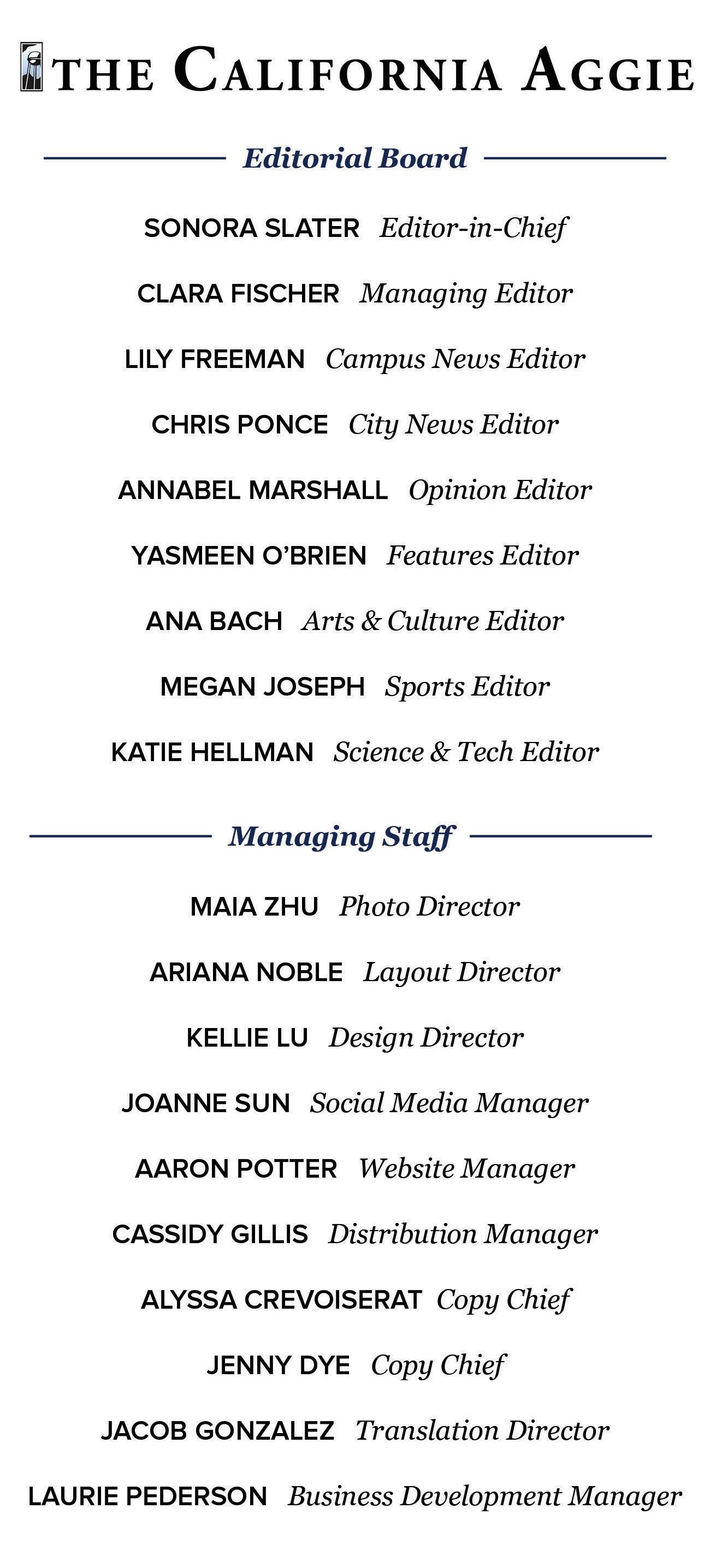
With ‘two years left,’ we have to embrace technology to survive climate change
We
must remain realistic as we fight to reverse global warming
BY MAYA KORNYEYEVA mkornyeyeva@ucdavis.eduyou couldn’t fly through a season of television all in one night; each one was special.
Now, the industry is saturated to the point where it’s easy to move from movie to movie or from show to show without paying that much attention to its craft, which means that production companies can get away with putting less effort into what they produce. We don’t demand the same height of quality, so they don’t supply it for us. It’s a tandem effect: as an audience, we want more content and we want it now, so production labels have to cut quality in order to keep up. As we consume increasing amounts of content, we care less about the quality, so production labels put less effort into their projects. And it feeds back into itself; we’re left unsatisfied by subpar media, so we ask for more. Creators need to move faster to make more content, and the cycle begins anew.
Another element is that artists don’t earn nearly as much revenue from streamed content as they do from other, more traditional distribution formats. In an atmosphere dominated by streaming, they have to release a greater quantity of content to turn a significant profit.
Streams are also unprecedented in that, with regard to music, consumers have to listen to a certain percentage of the song for it to count as a “sale.” This leads artists to strategically orient their songs so that the catchiest, most-likelyto-get-stuck-in-your-head parts are near the beginning. If the beginning of a song doesn’t capture your attention, you might skip to the next one. Artists benefit financially from starting their songs with the hook because it draws you in, and you’ll be more inclined to listen to it in its entirety. This phenomenon is creating an empirical pattern in modern pop music — we’re seeing more and more songs kick off with the chorus or the hook. Sabrina Carpenter’s new single, “Espresso,” is a good example: it opens with the chorus.

Recently, the United Nations (UN) Climate Chief Simon Stiell announced that “humans only have 2 years to save the world,” a prediction that paints irreversible climate change as practically inevitable. I met this announcement, to no surprise, with anxiety, fear and a great amount of speculation: what exactly is going to happen in two years, and how are we supposed to adapt to this new deadline?
Given the fact that climate change is the No. 1 source of concern in the modern world, with over a million people in the 2021 UN global climate poll labeling it as a “global emergency,” progress towards a sustainable future is moving along much more slowly than anticipated. Carbon emissions — one of the biggest contributors to air pollution, plastic production and global warming — aren’t being decreased in a way that is radical enough to make a significant and long-lasting impact before the end of the decade. A global capitalist economy continues to contribute to the over-consumption of nonrenewable materials, which pile up in the streets, in parks and on beaches, filling the oceans with plastic. Money, yet again, is winning over the very real and crucial need to reform society in a sustainable way.
However, the last several years have proved incredibly fruitful in creating new, progressive technology for environmentally-conscious farming and agricultural practices. Intermixed and often hidden behind news stories of dark predictions and climateinduced natural disasters are dozens of studies about new food technology, from climate-resistant crops to urban farming.
Focus has been dedicated to food production and management, and I would like to highlight some of the most important and innovative steps forward based on research beginning at the start of the decade and spanning over the last four years. The first and most curious new technology is an Artificial Intelligence (AI)-powered raspberry-picking robot, which allows scientists to reduce food waste and pick the ripest berries at the best times (night and early morning). Because raspberries are extremely fragile, the robotic machine preserves the berries by picking them with a soft, silicone-coated arm, which creates cushioning during harvest. I find this to be a very creative approach to ensuring that nothing goes to waste while also saving farm workers long, physically demanding labor.
Another unique approach to agriculture is vertical farming, a system that is being pioneered in Dubai at a growth center called the “GigaFarm.” This 31,000-square-foot tower of vertical growing spaces has already replaced up to 1% of food imports in the United Arab Emirates (UAE) and produces three million kilograms of fresh produce annually as of 2022. This concept focuses on land as the central constraint of agriculture. It attempts to consolidate ground for farming into a vertical rather than horizontal orientation, essentially to “save space” for other uses such as housing an increasing population. The facility includes technologies that transform waste streams (such as food scraps and sewage) into fertilizer, water and energy.
Local creatives gather each month to show, sell and celebrate their work
BY SAVANNAH ANNO arts@theaggie.org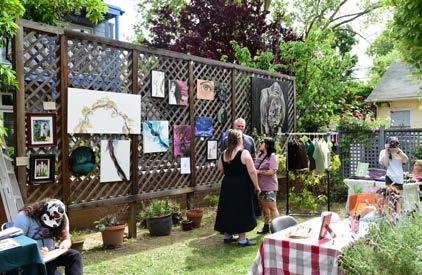
On April 27, local and regional artists gathered together to create a show, but not in a museum. Instead, they filled the space of a large backyard, hanging artwork onto the fences and setting up table displays for vendors.
This backyard show is known as The Boneyard. Organized and led by local artist Cassidy Ruiz, The Boneyard is a Do-It-Yourself (DIY), mobile art show that officially began on Jan. 5. Being mobile, the show has been hosted at locations like Turtle House and the local Rocknasium rock climbing gym.
The Boneyard at this month’s location, the Dizzy Cottage, featured live music, snacks and drinks. The show offered community painting where guests were encouraged to work together and paint designs onto a single, large tapestry. Towards the end of the night, the tapestry was a kaleidoscope of color: animals, abstract shapes, short messages and more littered the canvas cloth.
Ruiz created the mobile show to provide more opportunities for local artists to display and sell their work, aiming to make gallery space more accessible. The Boneyard acts as a celebration of and space for Davis’ creativity.
“I’ve really struggled with getting into the bigger art spaces in Davis,” Ruiz
said. “There’s a lot of requirements and there’s a lot of really difficult loopholes you have to go through. With something like this [The Boneyard], you don’t need a business license, you just show up and get to do it.”
Similar to Davis spaces like The Secret Spot and Third Space Art Collective, The Boneyard provides a platform for artists of all kinds, encouraging and welcoming diversity.
Hosting monthly events, The Boneyard is able to showcase a variety of artists and vendors. The Boneyard at Dizzy Cottage featured more than 15 makers; visitors could find jewelry, press-on nails, crocheted sweaters, keychains, stickers and more.
One local vendor, Lydia Chang, discussed the importance of events like The Boneyard in her career as an artist.
“I love connecting with people over art,” Chang said. “Having local events and getting to meet other artists and people in the community is really amazing. I love talking about my art and learning how people can relate to it.”
Chang — also known as artfulyds on Etsy — creates stickers, keychains, rugs and even zines. Chang’s zines have been able to further connect her with visitors, relating to their messages on
mental health, racial identity and more.
With a variety of artists, themes and mediums, The Boneyard has something for every visitor to enjoy.
“Everybody is so cool and unique in their own way,” Ruiz said. “Everybody brings something new to the table. What I love is that it’s all so different, we’re breaking barriers and doing something that people don’t always see” Ruiz hopes to expand the range of The Boneyard even further, aiming to eventually plan shows in both Sacramento and San Francisco. In the future, they aim to travel across the country — spotlighting communities of artists everywhere.
In the upcoming months, be sure to look out for where The Boneyard is traveling next. You can catch the show next month at the Rocknasium on May 5, or at The Growing Groves’ Pride Party on June 8.
If you’re interested in showing off your own work or being a vendor for one of The Boneyard’s events, you can visit their website and fill out a vendor application form. The show is currently accepting applications for the Pride Party at The Growing Groves until May 24, specifically looking to uplift and feature queer creators.
California’s ultimate urban park has something for everyone
BY SAVANNAH BURGERarts@theaggie.org
Looking for something fun to do in one of Northern California’s most iconic cities? San Francisco’s Golden Gate Park is the place for you! Boasting 1,017 acres, the park is 20% larger than Central Park in New York and is the third most-visited urban park in the country. There are limitless activities in the park, ranging from permanent museums to seasonal festivals and weekly concerts. This article will detail a handful of fun ways to pass the time. First off, for anyone who hasn’t been yet, consider going to the California Academy of Sciences. Although the ticket prices are a little hefty, especially for college students with general admission ranging between $33 and $45 for adults depending on the day and time, the Academy is full of hours worth of fun. When visiting the Academy, you can experience the underground Steinhart Aquarium, which houses tropical, amazonian and bioluminescent fish (among many others). For more wildlife, visit the Osher Rainforest, a four-story dome-encased rainforest filled with plants, butterflies, reptiles, free-flying birds and amphibians. Lastly, the Morrison Planetarium transports you to distant galaxies while the Shake House, the Academy’s infamous earthquake simulator, brings you back down to Earth with simulations of the 1906 and 1989 earthquakes. These are just a few of the things that the California Academy of Sciences has to offer. Just next to the Academy, the Legion of Honor and de Young Museum, known as the Fine Art Museums of San Francisco, offer a swath of amazing, world-famous works of art. At both museums, general admission is $20 and the student price is only $11 (bring your student ID). When visiting, you can see breathtaking art from the likes of Aaron Douglas, Claude Monet, Georgia O’Keefe and Georges Seurat.
As far as flowers and nature go, the
Japanese Tea Garden, Conservatory of Flowers and San Francisco Botanical Garden, otherwise referred to as the Gardens of Golden Gate Park, are phenomenal options. If you want to visit all three gardens for one discounted ticket price, the Gardens of Golden Gate Park Pass has a general admission price of $33. Otherwise, general admission for adults is $14 each at the Conservatory of Flowers and San Francisco Botanical Garden, with the Japanese Tea Garden ranging from $15 to $18 throughout the week.
Visiting the Japanese Tea Garden, you can witness a well-maintained Japanese-style garden, complete with pagodas, native Japanese plants, arched drum bridges, stone lanterns and koi ponds, all the while sipping on green tea in the tea house. Admission is free every Monday, Wednesday and Friday from 9 to 10 a.m.
The Conservatory of Flowers, modeled after the Princess of Wales Conservatory in Kew, England, is a jaw-dropping and humid collection of aquatic plants, highland tropical plants, lowland tropical plants and Scarlet, the famous and rare corpse flower. Admission is free every first Tuesday of the month.
For a more cardio-centered garden experience, the 55 acres of the San Francisco Botanical Garden has plants from Australia, California, Southeast Asia, Temperate Asia, South Africa, New Zealand, the Mediterranean, Chile and Central America. There is also the Helen Crocker Russell Library of Horticulture, which has books available for public viewing about subjects ranging from garden design to ethnobotany and sustainable agriculture. Admission is free every second Tuesday of the month and between 7:30 and 9 a.m. every day of the week.
Golden Gate Park features a variety of experiences that you can walk into free of cost. Continuing the theme of gardens, the Shakespeare Garden has
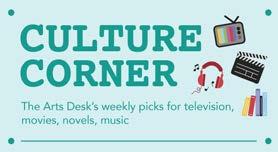 BY NATALIE SALTER arts@theaggie.org
BY NATALIE SALTER arts@theaggie.org
Film: “How To Lose A Guy In 10 Days” dir. by Donald Petrie (2003)


All bets are on in the iconic “How To Lose A Guy In 10 Days,” a romantic comedy starring Kate Hudson and Matthew McConaughey that has proven to be a timeless classic of the genre. Beauty and lifestyle journalist Andie Anderson (Hudson) takes on a challenge for her newest article: to drive away an interested guy as a what-not-to-do advice piece for hopeful romantics. Her target is Ben Barry (McConaughey), a charming executive who has made a bet of his own to make a woman fall in love with him before an approaching gala. A hilarious tale of love and misfortune ensues, with Andie and Ben realizing what started as a game may be more serious than they initially intended. It’s romantic, charming and has plenty of humor, making it a worthy watch for your next movie night.
Song: “Super Shy” by NewJeans (2023)
K-pop girl group NewJeans took the world by storm in the summer of 2022 with their debut single “Attention,” and since then, they’ve continued to stun with an assortment of catchy and creatively composed hits defining a new yet memorable career. On “Super Shy,” NewJeans are as bright as ever, with their playful voices bringing a refreshing and infectious beat to life. Combined with standout choreography and a colorful music video, it’s the perfect song to have on repeat this spring and summer. You’ll find yourself just having to sing along, and it’s a gateway drug to the iconic and iridescent world that is NewJeans’ music.
Book: “A Day of Fallen Night” by Samantha Shannon (2023)



In a stunning prequel to “The Priory of the Orange Tree,” author Samatha Shannon welcomes readers back into a lush and diverse fantasy universe filled with magic, culture and wonderment. This time, the story follows a series of mothers and daughters across the world’s various nations and each of their struggles to grow together and individually. Despite their distance in culture and country, the stories of these women intersect, and the ways in which they affect each other shape the course of history forevermore. Shannon is a master at character depth and complex, emotionally nuanced relationships. Furthermore, the enchanting universe she has crafted for readers to explore is endlessly fascinating and easy to fall in love with. With this dazzling prequel, Shannon has proved herself a rising master of the fantasy genre, and her works are absolutely worth your while.
Album: “A Night at the Symphony” by Laufey & The Iceland Symphony Orchestra (2023)
The captivatingly talented Laufey, who has already enchanted listeners with her marvelous voice and lyrical prowess, has paired with the Iceland Symphony Orchestra to craft a gorgeous live album befitting of her brilliant career. Composed of Laufey’s own original songs and her covers of classic jazz standards, the orchestral touch that the Iceland Symphony Orchestra brings to this album takes the music to the next level. It’s a delightful listen from start to finish, with the orchestra’s magnificent instrumentals and Laufey’s unforgettable vocals coming together to create a truly magical musical experience. The album is a wonderfully crafted look at Laufey’s career so far, and if its quality is any indication, her future is just as bright.
over 200 species of flowers and plants, including every flower mentioned in Shakespeare’s plays and poems, hence the name. It’s also a popular venue for weddings. You can also venture to the Dutch Windmill and Queen Wilhelmina Tulip Garden for a little taste of Holland in California. The garden features hundreds of colored tulips that bloom in early spring. Thinking of a hike? Golden Gate Park has 33 acres of lakes, with many having trails circling them. Some of the most popular lakes to visit are
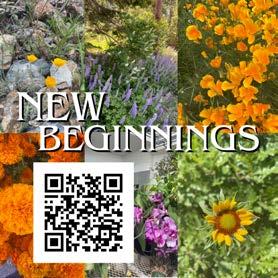
a queer cult classic film — but more so in its implicit coding
On its 22nd anniversary, the film’s explicit intersectional queerness and implicit sapphism stands as a celebration of its underrepresented communities
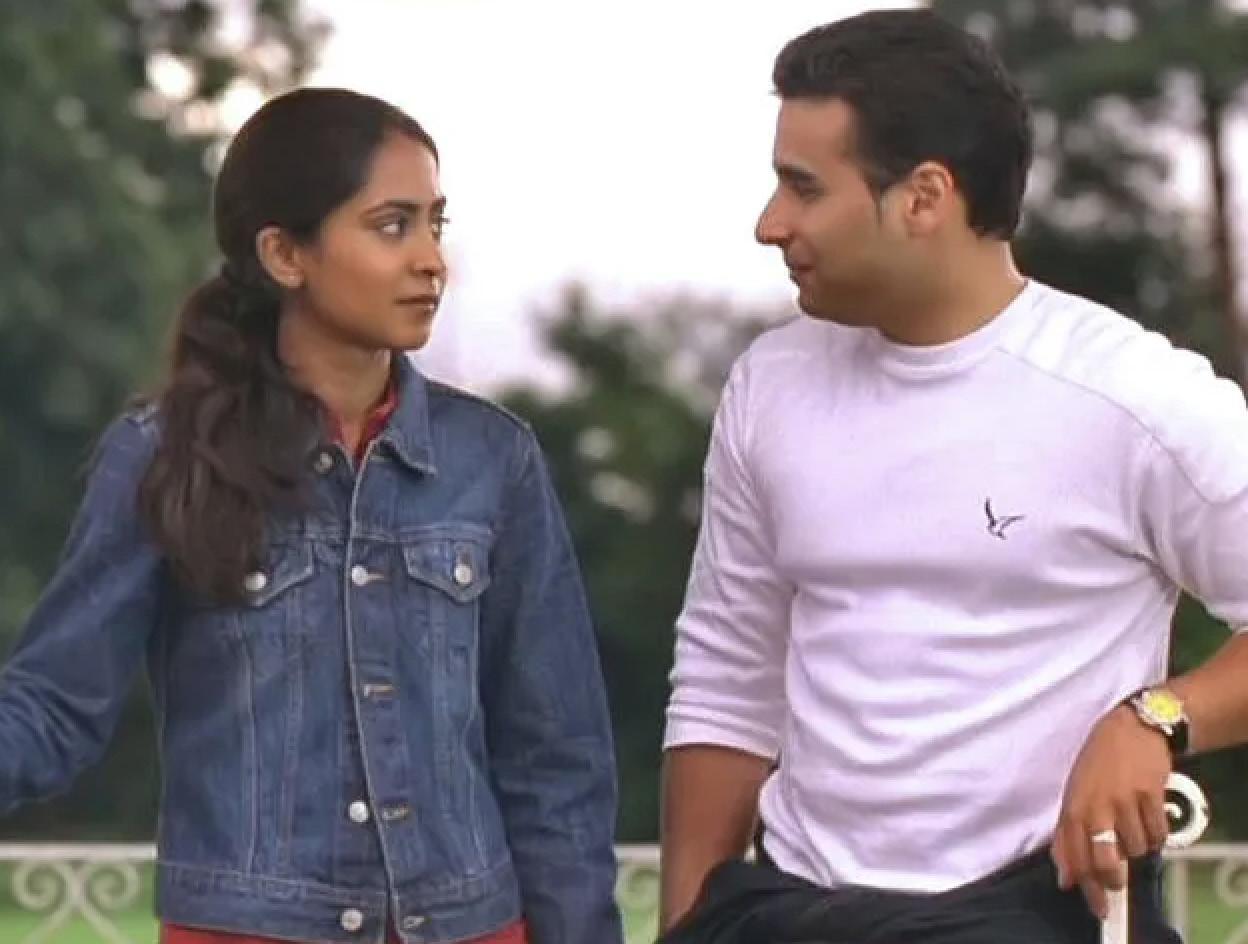 BY INDRANIL BASU arts@theaggie.org
BY INDRANIL BASU arts@theaggie.org
“Bend It Like Beckham” is a 2002 sports comedy-drama film directed by Gurinder Chadha and written by Chadha, Paul Mayeda Berges and Guljit Bindra. The film follows the story of Jess Bhamra (Parminder Nagra), who is the daughter of Sikh Punjabi immigrants in Hounslow, London. She has just graduated high school and is preparing for her elder sister’s wedding in the summer before university. Jules Paxton (Keira Knightly), a member of a local women’s amateur football team called the Hounslow Harriers, notices her skills at a local park and invites her to try out for the team. The film’s central characters as well as the main plot are not explicitly queer, but “Bend It Like Beckham” is iconic as a queer film because of its heavily sapphic-coded relationship between Jess and Jules. Despite this, the film does explicitly deal with queerness in two subplots with positive representation.
Jess’ close friend, Tony (Ameet Chana), who is also South Asian, comes out to her about halfway through the film. Subtly but surely, when Jess and him are discussing their liking for David
Beckham, the film’s namesake, Tony says, “No, Jess. I really like Beckham,” emphasizing the “really.” After a moment of connecting the dots in her mind, understanding the difference in their ways of liking him between her idolizing the star athlete as opposed to Tony’s sexual attraction toward him, Jess’ response is, “But you’re Indian!”
This highlights the dichotomy of identities that are expected of diasporic Indians when it comes to queerness.
To have an intersection in these identities, thanks to Western imposition of homophobia, is unfathomable. Therefore, having this Indian-British character portrayed as queer in 2002 was groundbreaking, especially for the rarely represented South Asian queer communities. It is quite fascinating to see how this representation didn’t pan out in more films — the film’s acknowledgment of this struggle, even in a subplot, was greatly significant.
The other subplot is Jules’ white British mother overhearing a conversation between Jess and Jules, thinking that they were involved romantically and that Jess broke Jules’ heart.
Recent casting rumors spark conversation over the popular children’s story
BY LORENA ALVAREZ arts@theaggie.orgDisney holds a track record as one of the leading brands worldwide, but that does not shield the company from backlash. While they are known for their children-oriented animations, their live-action remakes appeal to their older audience. This childhood nostalgia can often lead to an uproar over casting decisions.
While Disney has yet to confirm plans for a live-action “Tangled,” let alone casting decisions, the rumors of a remake have been met with criticism, with some fans voicing their (dis) approval of the fan-casting of Avantika Vandanapu as Rapunzel. In light of the recent controversy, the following is a commentary discussing the meaning behind the Grimm brothers’ original tale and Disney’s “Tangled.”
Although Disney fans picture Rapunzel as a young girl with long golden locks, Rapunzel’s hair and race are not key factors in the overarching message of the story. The original version does not even emphasize her hair color, only mentioning it once in passing. Here, what is of importance is the fairytale’s cautionary tale.
Grimm’s 1812
“Children and Household Tales” version follows a couple who is punished for trespassing into the garden of Frau Gothel, a powerful sorceress. The text warns of the dangers of greed and temptation as a man steals in response to his wife’s “longing” for an edible purple wildflower “belonging to a sorceress who possessed great power and was feared by everyone.”
The acknowledgment that people were not welcome to take from the sorceress’ garden suggests that the couple, although driven by great desire, are in the wrong as they deliberately go behind the sorceress’ back to steal from her.
When the sorceress catches the man trespassing for the second time, she is angered that the man steals from her rather than asking if she could spare some rampion for his pregnant wife.
“How dare you climb over into my garden like a thief, and steal my rampion! It shall be the worse for you!” Gothel said in the story.
The message encouraging people to be truthful as well as grateful is further emphasized at the end of the tale, where
The film was recently released on Netflix after a successful box office run in late 2023
 BY AALIYAH ESPAÑOL-RIVAS
BY AALIYAH ESPAÑOL-RIVAS
arts@theaggie.org
In the ever-evolving landscape of romance comedies, certain releases emerge as glimmers of hope, rekindling the popularity of the genre. Think back to films like “To All The Boys I’ve Loved Before,” “Crazy Rich Asians” and “Palm Springs.” Yet, amidst these films, the modern rom-com genre remains diluted with mediocrity, as most fade into obscurity right after their release. While the film “Anyone But You” initially seemed like an optimistic contender due to the buzz it received on social media, the film failed to leave a lasting impression on me. At the heart of any notable rom-com lies the crucial element of chemistry. Regrettably, “Anyone But You” fails to obtain this due to its lack of emotional depth and plot akin to a Wattpad story. The only defining factor that separates the film from any other rom-com is its budget, making it as forgettable as all three installments of “The Kissing Booth.” The film follows Bea (Sydney Sweeney) and Ben (Glen Powell),
two strangers who share an awkward interaction that ignites “instant sparks.”
From that one interaction alone, they decide to have their first date the same day, leading to a night full of grilled cheese sandwiches, sharing secrets and sleeping together. However, when Bea leaves in the morning without telling Ben, he instantly gets defensive and tells his friend Pete how awful of a person Bea is. To his dismay, Bea overhears all of this and the two decidedly hate one another.
Flash forward to six months later, the two meet again at a bar when Bea’s sister announces she’s marrying Ben’s best friend’s sister. Following this, Bea and Ben embark to Australia, where the wedding party is forced to stay in a house together. But to no one’s surprise, the situation becomes even more awkward as both Bea and Ben’s exes are also there. Despite this, the two decide to fake a relationship to make their exes jealous. Just 40 minutes into the movie and there’s already a loversto-enemies plot, reappearing exes and fake dating.
Yet Bea and Ben’s fake dating plan is horribly executed as their hatred for one another is made obvious through

With the recent announcement of other classic Disney live-action remakes, fans have speculated a “Tangled” version coming in 2025. Fans have even created trailers on YouTube. (Courtesy of Walt Disney Productions / fair use)
Gothel cuts Rapunzel’s beautiful locks after discovering that her “daughter” has also betrayed her.
“I thought I had hidden thee from all the world, and thou hast betrayed me!” Gothel said.
As the story concludes with Rapunzel reuniting with the king’s son after living “in great woe and misery” as their punishment, the household tale warns children against disobeying their guardians and giving into temptation.
While Grimm’s version teaches children to be loyal and ask before taking things from people, Disney’s adaptation is a modernized take exploring the good that can come from taking risks and believing in oneself.
“Tangled” follows Rapunzel as she takes agency over her life that has been stolen from her by Mother Gothel and helps Flynn Rider, a thief, redeem himself by helping her leave the tower. For those unfamiliar with the story, Rapunzel dreams of leaving the tower in hopes of seeing the yearly lanterns that cover the sky on her birthday.
The iconic song “When Will My Life Begin? (Reprise 2)” depicts Rapunzel’s struggle to overcome her fears and explore the scary world that she believes Gothel has been protecting her from.
The ‘cult’
“Look at the world so close and I’m halfway to it,” Rapunzel sings. “Look at it all, so big, do I even dare? Look at me, there at last, I just have to do it […] here I go.”
The animation pairs these lyrics with a scene of Rapunzel cautiously pausing before stepping on the grass, and leaving her tower’s safety (and isolation). Through this, the scene highlights the fear and anxiety she must overcome to make her dream of leaving the tower a reality.
As she demands that Rider take her to see the lights, the script stresses the importance of taking an active role in the direction of one’s own life.
“You will act as my guide, take me to these lanterns, and return me home safely,” Rapunzel said. “Then, and only then, will I return your satchel to you.”.
Thus, classics like Rapunzel’s story play an important role in teaching young impressionable people valuable life lessons — both Grimm’s and Disney’s versions warn against theft, but the latter’s version adapts the story to encourage agency and bravery. While there is a lot of controversy over whether adaptations are better than the originals, taking a popular story and adapting it to meet modern audiences can oftentimes do more good than harm.
HBO documentary “Brandy Hellville” reminds us of the dangers of overconsumption
BY JULIE HUANG arts@theaggie.orgconstant bickering which steals the spotlight from the main couple who is actually getting married. But it wouldn’t be a rom-com if there wasn’t romance, hence in the supposed climax of the film, the two realize that maybe they don’t want anyone else but themselves. Despite this, the third act brings another conflict for the two and shows how deeply flawed the two are. Ultimately, the two get together despite their differences, resulting in an ending sequence accompanied by the song “Unwritten” by Natasha Bedingfield. Overall, the film exemplifies Hollywood’s problem with producing rom-coms: the prioritization of star power over genuine chemistry. This isn’t to criticize Sydney Sweeney’s or Glen Powell’s acting skills per say, but their portrayal of romance falls short of convincing. It’s almost as if so much and yet so little happens in the film due to the overshadowing of their lackluster acting as a couple. If you want a predictable rom-com with oversexualized characters that don’t compensate for their lack of connection, then this is the film for you.
If you’ve scrolled TikTok recently, there’s a chance that you’ve stumbled upon video after video about “Brandy Hellville & The Cult of Fast Fashion,” an aptly named HBO documentary exploring the less-than-ethical business practices of popular clothing brand Brandy Melville. The documentary’s exposure has sparked online discussion around the brand, making buyers further their awareness of their own clothing choices and how fast fashion has taken over their closets. As it turns out, the “Brandy Hellville” documentary presented a scathing but compelling exploration of Brandy Melville’s toxic impacts on the environment, cultural trends and working conditions. Many had been vaguely aware that there were some controversies surrounding the brand, specifically its unconventional — and often exclusionary — sizing practices, but the documentary shed new light on how the trendy clothing brand embodies the worst elements of the fashion industry and consumer culture itself.
Brandy’s business decisions are insidiously designed to encourage excessive consumption. For one, there’s a sense of false scarcity surrounding clothing items. Pieces are rotated out from store to store, and customers never know which items will be in store that day. The retailer’s online website faces a similar situation. Items are added or removed from the site without any fanfare, encouraging shoppers to buy something that they have their eye on rather than pass it up and potentially miss out on something forever. It’s easy to cave into this manipulative business tactic. However, shoppers ultimately end up contributing to the ever-expanding problem of overconsumption.
Perhaps singling out individuals for their wardrobe choices is not enough without situating them within the larger context of our society’s consumer culture, which has now taken on a life of its own, fuelled by fleeting micro-trends and the rapid production cycles that follow suit.
Social pressure to keep up with trends is often amplified by social media influencers positioning each item as selfcare or necessary, and the fast turnover for trends becomes a never-ending treadmill that can spiral into wasteful spending and shopping addictions. Online advertisements now take the form not only of traditional ads but also influencers posting their latest shopping hauls and innocuous-seeming product reviews that get people talking, thinking and wanting to buy.
Brands like Brandy can take advantage of the human tendencies to conform and covet, but when does personal responsibility begin to factor into this landscape dominated by fast fashion?
Though the question of sustainability is highly multi-faceted, our buying choices can reveal what we are willing to support and what we are willing to ignore. Environmental sustainability is threatened by the mass production of clothes made of synthetic fabrics such as polyester, a kind of plastic that cannot decompose and yet is often used to produce fast fashion pieces that get thrown away as soon as they lose trendiness.
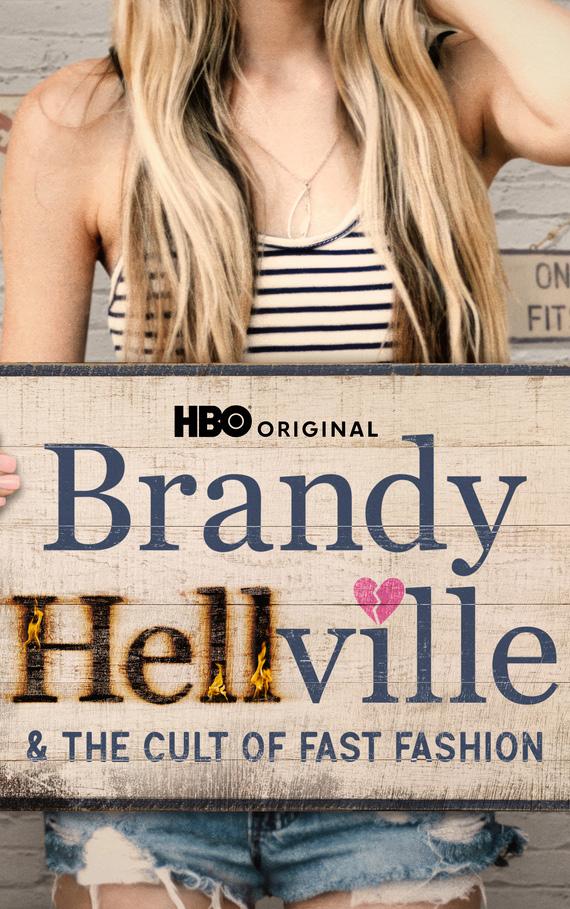
The team will continue to compete in a multitude of collegiate tournaments
BY MADISON PETERS campus@theaggie.orgThe UC Davis Esports team competes in tournaments nationwide and is continuing their success as one of the top collegiate-level esports teams in the country.
The esports club is composed of 13 teams playing across eight different titles, or video games, and was created in the summer of 2021.
Kevin Deras-Guerra, a fourth-year biological sciences major and former director of the Esports team, explained what esports entail.
“[It’s] competitive gaming between college campuses,” Deras-Guerra said. “It’s more like a collection of different competitions. Depending on the title, there are different teams that colleges will levy, and then they’ll go up against each other. These [tournaments] are usually hosted by third-party competitive bodies.”
The team plays a range of titles, including Rainbow 6 Siege (R6), Rocket League, Overwatch and many more, with the most popular titles being Valorant and League of Legends, according to Deras-Guerra.
Within the Esports club, there are three subteams: the Gold Team, Blue Team and White Team. DerasGuerra leads the Gold Team, which he describes as the equivalent of an A team in other sports, for R6.
Darren Son, a fourth-year art major and the R6 Gold Team starter, elaborated on his experience with the team.
“My favorite part about being [on] an esports team is the feeling of everyone working towards the same goal,” Son said. “Everyone is putting their effort into it and making connections within the team. I also love meeting new people from other
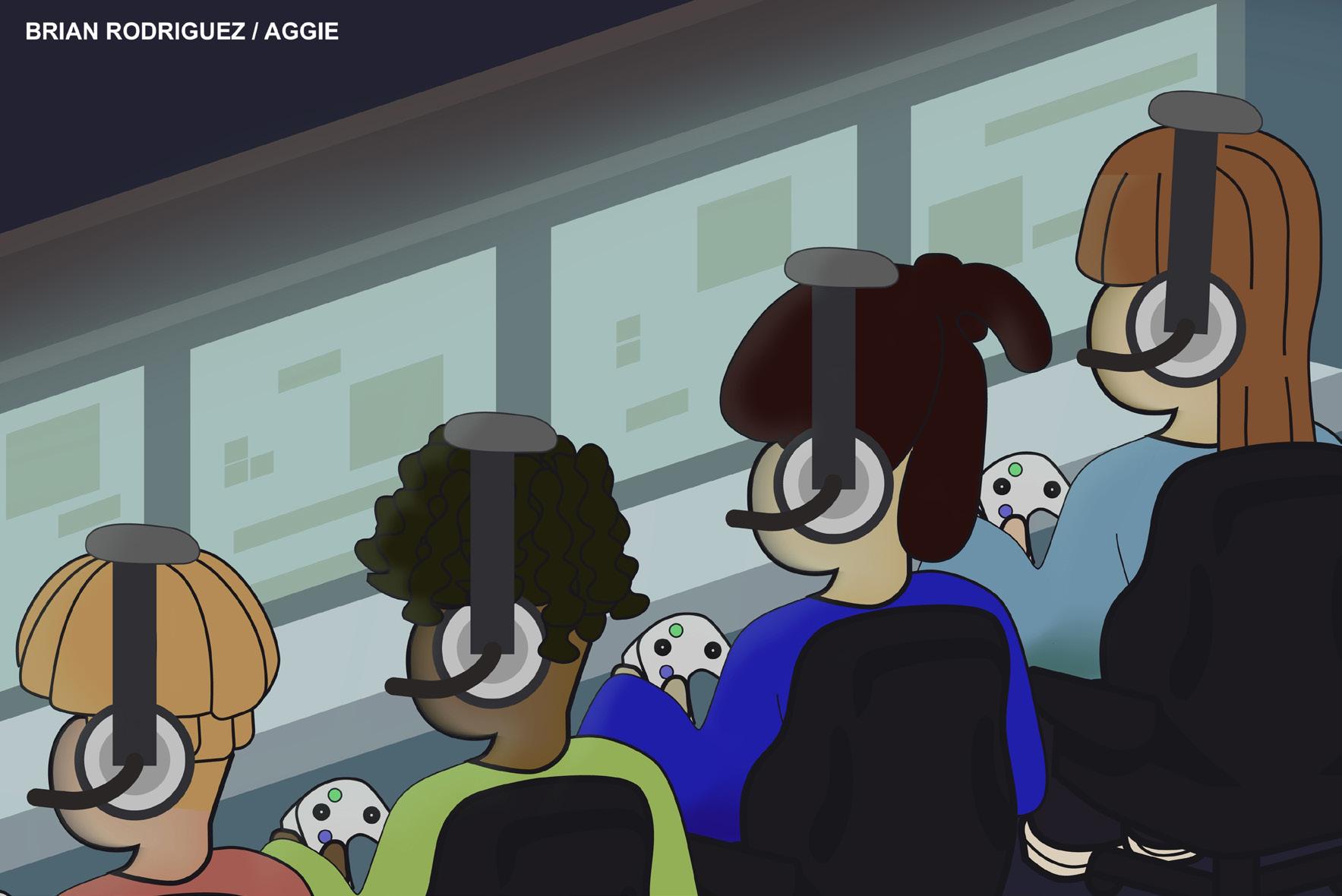
teams we compete against. It’s a great way to find people who have the same interests.”
UC Davis Esports has competed and placed within the top 25 teams at a variety of national tournaments.
In recent years, they were announced as tournament winners of both the 2023 University of California Esports Invitational and the 2023 Skyline Gaming Inaugural Season. They also placed fifth at the Colonial Bash Charity Tournament for Pittsburgh Food Bank.
At their peak in fall of 2023, UC Davis Esports placed 19th in the nation and according to DerasGuerra, they are a top 20 school overall in collegiate esports.
The team is currently hosting Moogie’s Valorant Throwdown, the first Valorant tournament they have orchestrated. Anyone who wishes to see the local area network (LAN) final round of the tournament can observe it at Cruess Hall on June 1.
The team is also preparing for their next big tournament, the West Coast Clash, which will be hosted by San Jose State University, according to Deras-Guerra.
Although they receive some funding from the university, the team is largely self-funded and has paid up to $3,000 out of pocket to attend their tournaments.
Deras-Guerra detailed what it takes to be a pro gamer.
California Transportation Commission seeks public input on new toll lanes to improve traffic conditions, planned for 2027
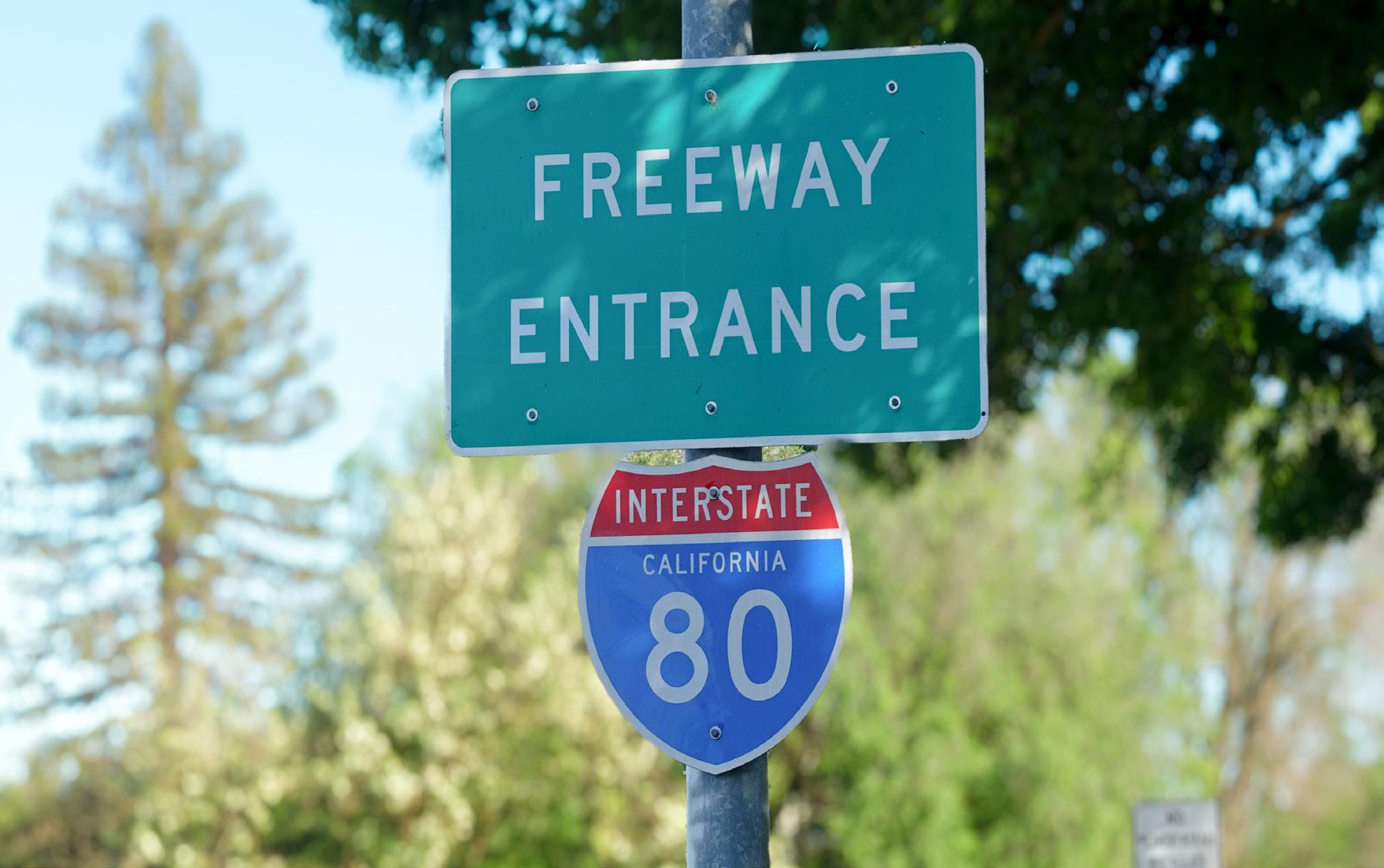 BY ALEXANDRA SHAPIRO city@theaggie.org
BY ALEXANDRA SHAPIRO city@theaggie.org
On April 9, the California Transportation Commission (CTC) held a public informational hearing in West Sacramento at the Arthur F. Turner Library to receive input regarding the proposed toll lanes for Interstate 80.
This meeting allowed community members to express their opinions and concerns directly to decision-makers. Attendees were able to participate in person or via Zoom.
The I-80 causeway in Yolo County faces a bottleneck with only three lanes and no alternative routes available. This congestion leads to traffic overflow onto country roads not designed for heavy traffic.
“In the area that the project covers, we have the highest amounts of congestion along the causeway,” CTC Executive Director Tanisha Taylor said during the presentation. “This is in part due to the fact that this is just one of two stretches where I-80 has three lanes between the Bay Bridge and Roseville.”
The presentation shared that the current peak evening eastbound travel time on the Yolo Causeway is 22 minutes for a 10-mile stretch. Without the Yolo 80 project, this is expected to skyrocket to 74 minutes by 2049.
Additionally, the CTC presentation noted 25 reported fatalities on the causeway in the last five years, with 61% occurring from congestion-related rearend accidents. These incidents cause significant backups on I-80 for miles and without proper infrastructure.
“There is no way to communicate conditions to drivers,” Taylor said.
The presentation also discussed bottlenecks at Mace Boulevard, with daily eastbound congestion lasting for five and a half hours while westbound traffic starts to back up on the causeway as early as 6:30 a.m.
Another proposed aspect of the project includes upgrading the causeway’s unique bike path on the freeway’s north side. According to the presentation, approximately 60 bike trips are made across the causeway daily, but with half a mile of deteriorated local road connections, this has resulted in multiple fatalities in the community. The hazardous road conditions create further incentives to avoid taking these alternative routes.
The presentation also shared that the most common complaint about transportation services along the I-80 is the slow and unreliable wait times for passenger cars and public transit.
Fourth-year anthropology major Athena Huerta said she often takes a three-mile detour to avoid congestion.
“I usually go the longer way, through Woodland,” Huerta said.”I don’t like touch-and-go traffic; there’s more ease of mind with this route, and I don’t have to be hyper-aware of traffic.” During the hearing, Sergio Aceves, the California Department of Transportation District 3 director, outlined the project scope. Adding a toll lane is expected to improve travel time reliability by 80%, with an estimated time savings of 37 minutes during peak hours, according to the data presented.
84 buses, including YoloBus and Paratransit services, pass through the project area each day. Without the additional lane built, travel time for this route is estimated to increase to 81 minutes compared to 35 minutes during free-flow traffic conditions. The Yolo 80 project would also include three additional round trips daily to the Capitol Corridor.
One of the commenters, Sam Rice, who serves as the president of the Environmental Democrats of Sacramento County, emphasized the importance of improving public transportation on the highway.
“We [the public] suggested in comments that there be at least two managed lanes, with one being a transitonly lane,” Rice said.
However, some disagreed, arguing that the project was already ambitious enough. Attendee Alan Hirsh, a political activist in Davis, raised concerns about the need for more of the public to attend this meeting.
“There was no press release [...] and the flier does not solicit public written comments,” Hirsh said.
Hirsh also noted the meeting’s location in West Sacramento instead of Davis, where there would be more effective tolls.
“If it [the hearing] was [held] outside of rush hour in Davis, we’d get 20 or 30 people here instead of three or four,” Hirsh said.
Other public commenters, including former West Sacramento mayor and State Senate candidate Christopher Cabaldon, voiced the importance of the project and their support. “Yolo County uniquely in this region has stepped up to say congestion pricing is the future,” Cabaldon said. “Managed lanes are the future. We are ready to do it.”
Yolo Transportation District (YoloTD) anticipates that tolls on I-80 for Davis commuters will reach $10 each way during congestion, potentially even higher. Vehicles with three or more occupants will go toll-free, prioritizing Tahoe groups over daily commuters. The board is discussing an equity program to ensure access to the toll lanes through discounts, transit passes, and other measures.
The Caltrans website shows the total estimated cost for the project could range from $230 to $465 million, funded partly through an $86 million federal grant. The project timeline estimates construction would begin this year and be complete in 2027, with toll collection starting in 2028.
Bootcamp, which, according to an article by Jeff E. Heiser, is intended to open a safe space for women and non-binary players to learn more about esports and get introduced to the gaming industry.
The UC Davis Esports website affirms these values.
“We are a sports club dedicated to developing a safe and inclusive environment for UC Davis gamers,” the website reads. “[We] believe that everyone has a chance to be involved in esports, regardless of their background or identity. Here, we are proud to manage diverse competitive teams, host inclusivity events and establish safe spaces in esports.”
Brian Crittendon, a fifth-year communications major and the R6 Gold Team starter, expressed the overall importance of esports on campus.
“It is extremely important to have an esports scene on campus,” Crittendon said. “Esports has proven that it’s here to stay and I think that offering a real way to experience it is invaluable.”
“I really think it just comes down to game time, to be honest,” DerasGuerra said. “It really is a mental thing. You focus on what you want out of the game and if you decide that you want to dedicate the time to it and you want to do it consistently, then that’s just what it takes. I think I put in four hours daily, at minimum, and that’s what I’ve been doing for four years. I’ve seen the improvement out of it, but a lot of people obviously can’t commit that time to it [...]I think that’s a big contributing factor to how people get into [competitive gaming].”
The esports team also preaches diversity and inclusion for gamers of all backgrounds. The White team hosts an annual Women in Esports
Besides just the competitive levels, Deras-Guerra said that esports is a rapidly growing industry including jobs such as tournament administration, production media, finance and various other positions. Son shared these sentiments and commented on the significance of campus esports in the midst of its growing industry.
“As gaming and esports [grow] bigger, it is crucial to have esports on campus,” Son said. “It is a place where people can come and connect with others in person rather than online. It builds a sense of community on campus and overall gets people together.”
A recap of UC Davis’ eighth annual Give Day
BY MI’ZAUNI REESE sports@theaggie.orgThis past weekend marked one of the most important days of the year for athletes and many Davis programs — Give Day. A two-day fundraising event for direct campus improvement, Give Day has been influential in funding a variety of Davis endeavors for years. Over the course of the two-day event, more than $400,000 was raised and sent to various programs on campus for the improvement of resources, equipment and support for all Aggie students and athletes. Give Day, created in 2017, is an event in which UC Davis donors can make donations, challenge other donors and fulfill specific “challenges” on campus. The main area of donation is the Annual Fund; this is a program of unrestricted funding that supports faculty research, scholarships and areas of greatest need. Included in this fund is the Chancellor’s Fellows program, supporting the 200 person faculty that works to make innovative breakthroughs in cellular biology, teen bullying, writing and artistic expression. The Annual Fund also pertains to the Chancellor’s Achievement Awards, granting access to education to highperforming California students from disadvantaged backgrounds.
For our Aggie athletes, this weekend means raising money for all 25 NCAA Division 1 Athletics teams as well as
the athletics department’s broader initiatives. Although donations are accepted year-round, Give Day is when our athletes encourage fans and supporters to make contributions. With donations starting at $5 for any fan or student, anyone can show their support for the Aggie teams. This year to celebrate the day, athletic teams were separated into groups of four or five and competed against other teams for the highest number of donors. The winner of each group was able to win a cooking class and team dinner with UC Davis’ Director of Performance Nutrition, Rachel Mack.
Since its creation, Give Day has raised over $2.1 million in gifts, with this year alone breaking the record for the most money raised in a single year. As the highest amount in UC Davis Give Day history, the athletics department raised a total of $436,878, and UC Davis as an institution raised $4,095,716.
The philanthropy of the Davis community including fans, students, staff and alumni allowed for all 13 of the challenge gifts to be completed, with one-third of the money going directly to athletics. Other programs such as Inclusive Excellence, Sports Medicine and Athletic Director’s Discretionary Fund were supported substantially by these donations. If you missed out on giving this weekend, there is always another opportunity to donate to any of their listed causes on their website.

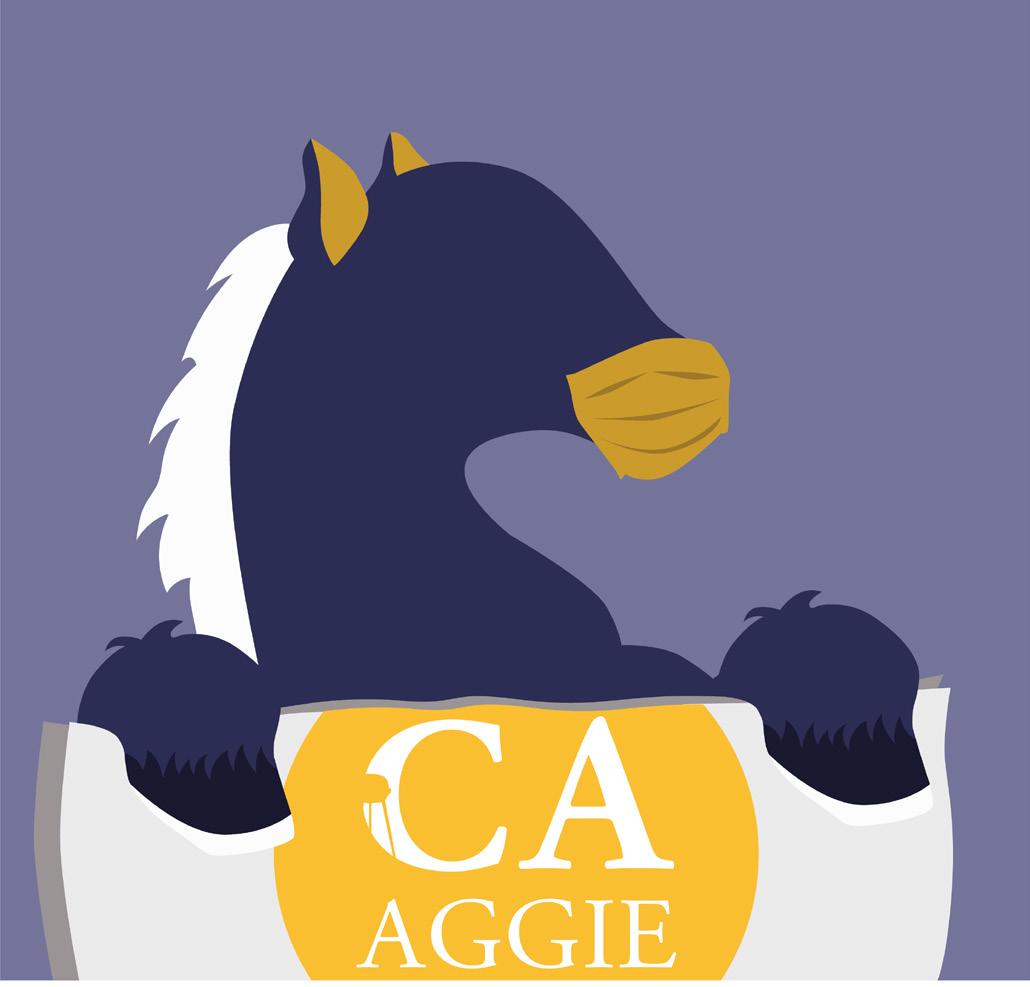
Enter digits from 1 to 9 into the blank spaces. Every row, column and 3x3 square must contain each digit. Each Sudoku has a unique solution that can be reached logically without guessing.
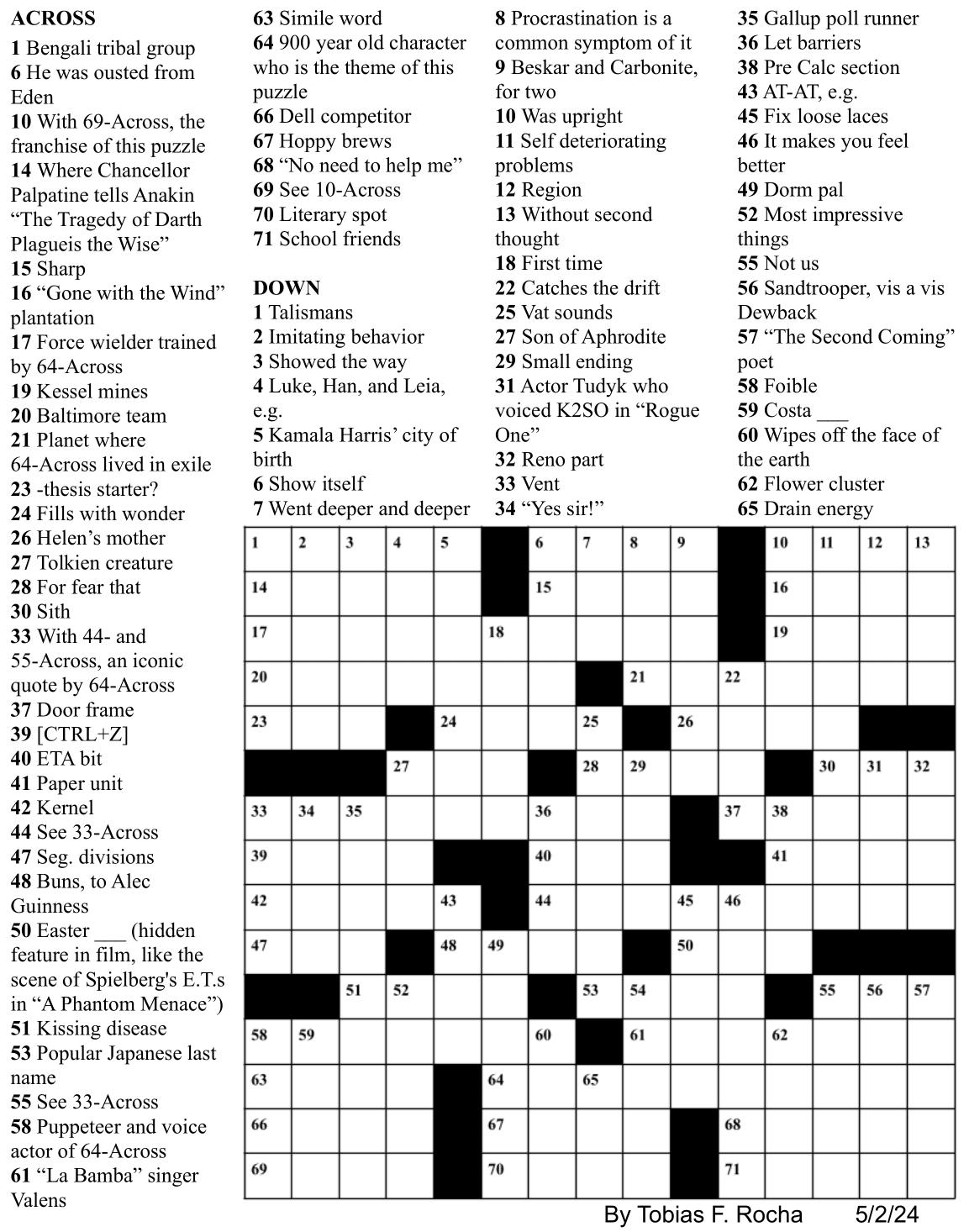
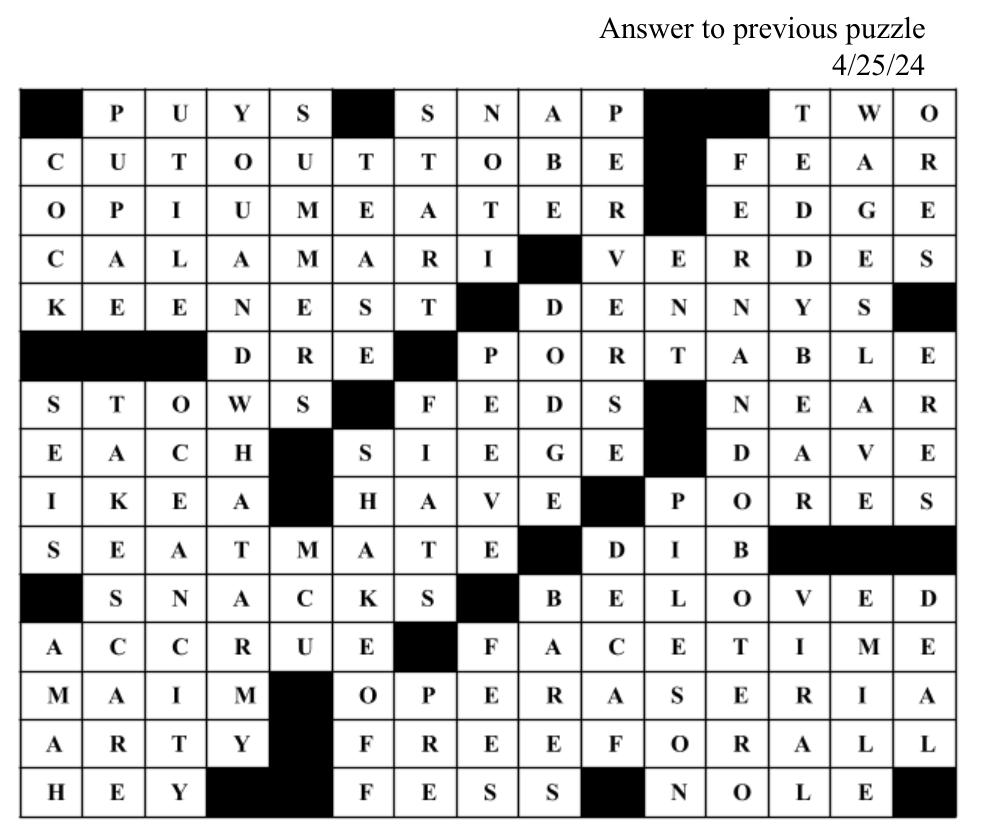 BY SANDHYA PFILE sbpfile@ucdavis.edu
BY SANDHYA PFILE sbpfile@ucdavis.edu
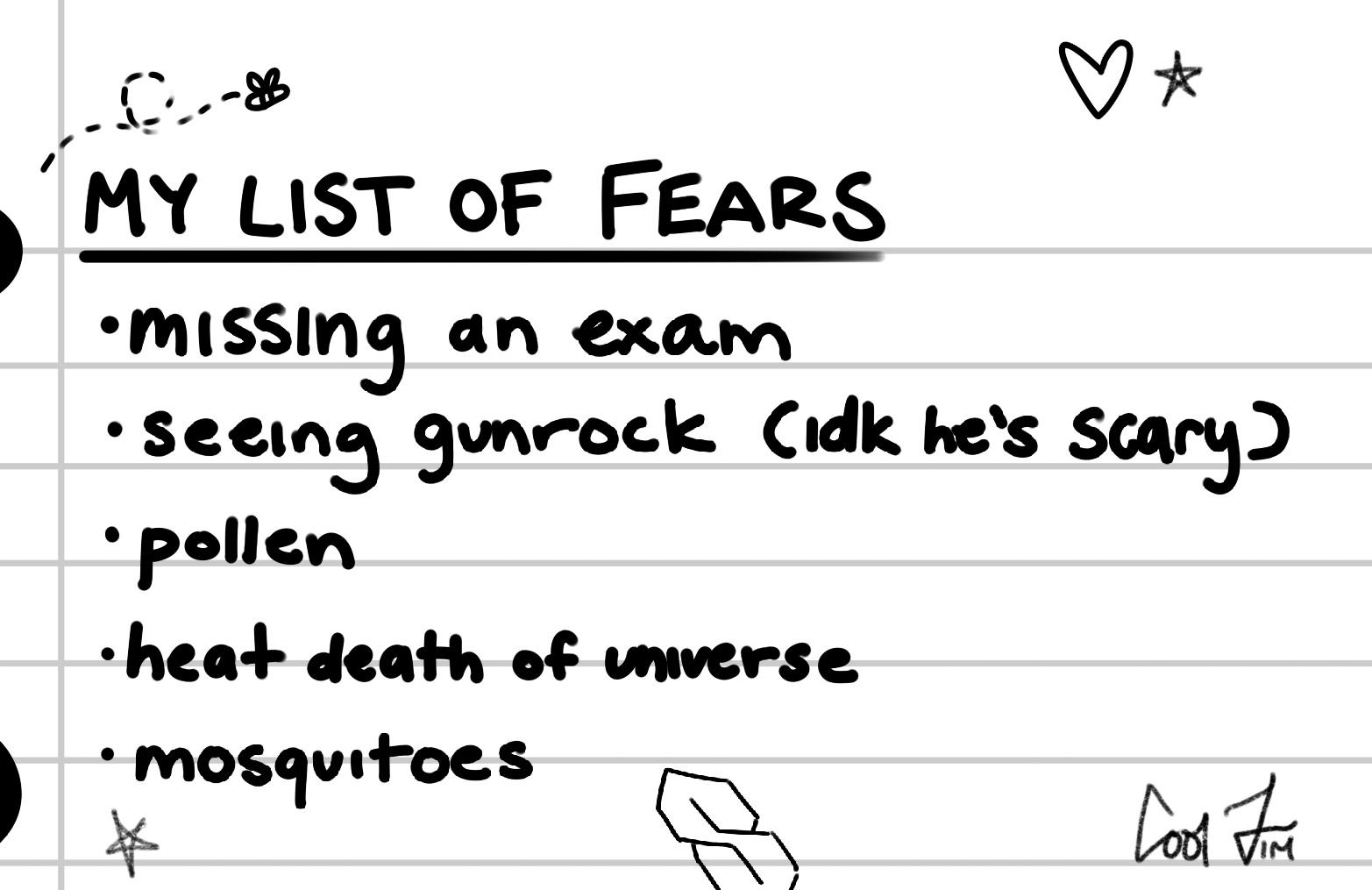
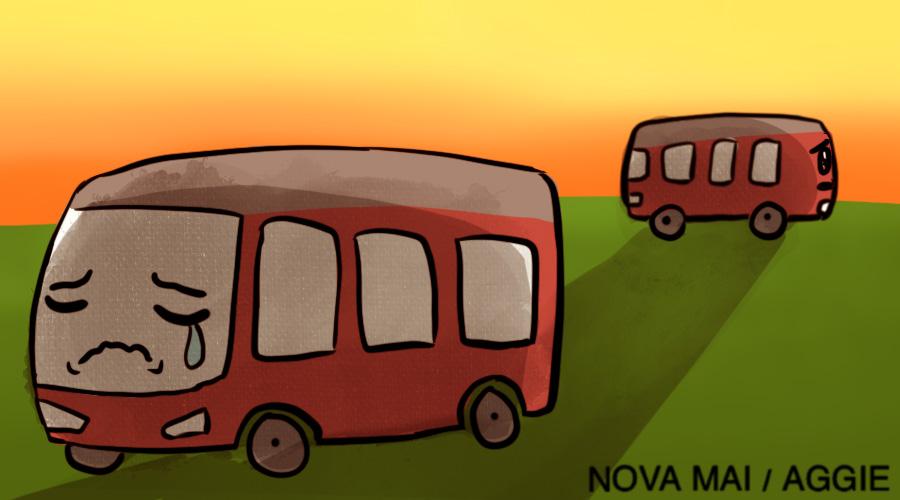
The local rock climbing gym’s pole dance showcase put on an engaging production
BY GRETA FOEHR features@theaggie.orgRocknasium, Davis’ local climbing gym and pole studio, hosted its second annual Pole Studio Showcase on April 20, 2024. The showcase featured a variety of pole dancing performances and select belly dance acts.
Imani Latif, a UC Davis alum and manager at Rocknasium, started the Rocknasium Pole Studio in 2016 when the studio that she was teaching at closed down. She decided to start teaching classes at Rocknasium and converted the yoga studio into a pole studio. Since then, the program has grown exponentially, with thousands of people passing through her classes. There are now four other instructors, but she was the sole teacher until 2021.
Last year, Latif decided to host a pole showcase for her students, a chance to demonstrate what they had been working on all year.
“I wanted it to be like a recital for people who want to show their friends and family the things that they have been working on,” Latif said. “In 2023, we had enough students, enough instructors and enough bandwidth to be able to put on a show. And then this year was the expansion of that.”
Last year, the showcase was in Rocknasium’s weight training area, which was too small to accommodate the growing popularity of the pole dance program. This year, Mark Leffler, Rocknasium’s owner, built a stage over what is normally the gym’s walkway, creating a theater-like setup where the audience sat in the middle
room of the gym under the climbing roof.
Jonathan Serna, a Davis resident and Rocknasium employee, was in charge of the lighting and filming for the showcase. He and his team climbed the gym walls to set up static lines to bring up the film equipment. They recorded the entire show, with the audience in the frame, from a point on the wall directly across from the stage. During the show, Serna also recorded the performers closely.
“It’s a very engaging experience to be the one to film,” Serna said. “I get to be in sync with the performers, with their movement, with the music, with their performance, with their emotions and feelings. And then, of course, I get to be a part of the audience too.”
Serna will be releasing a twominute highlight reel of the event on Rocknasium’s social media accounts.
The Studio Showcase not only had an elaborate backdrop and lighting setup but also engaging performances and an ecstatic audience. The audience was made up of friends and families of the performers, as well as Rocknasium members who wanted to experience the pole studio’s community and hard work. The event had around 150 attendees.
Serna appreciated the energy that the audience brought to the event.
“The audience was generally quite fanatic,” Serna said. “There was a lot of whooping, yelling, cursing, screaming and loving. It was a great turnout in terms of audience entertainment and reception.”
The performers put countless hours of work into their acts, and it paid off. They started attending
UC Davis students share books and advice that helped them learn to enjoy reading
BY ZOEY MORTAZAVI features@theaggie.orgIt’s no secret that reading is good for your brain. In fact, getting into the habit of consistently reading can work wonders for cognitive function, memory retention, stress reduction and general brain performance. College students are often expected to keep up with extensive reading for their courses, and that can become difficult for those who aren’t accustomed to reading regularly.
This can also be very difficult for students majoring in the STEM fields — which many Davis students are — who take courses with the most reading they experience in college as part of the general education requirement. In this case, dense readings can definitely pose a challenge, and students are often caught by surprise at the amount and intensity of readings after starting their classes.
UC Davis students have expressed that learning to read habitually and at a high level is crucial to balancing difficult academic subjects, especially as a new college student.
“Since starting at Davis, I’ve taken a lot of courses about politics and global policy. It’s easy to fall behind if you’re not used to reading regularly,” Isaiah Phillips, a first-year international relations major, said. “Studying becomes way easier once you’re good at analyzing written material. Reading often can assist with that and help you succeed in your classes, even if you’re just reading books that you find interesting that aren’t necessarily academic.”
Students at Davis who have found a love for reading discussed the books that helped them find this deeper
appreciation as well as how reading has helped them in other areas of their lives.
Molly Thompson, a first-year communications major, shared her favorite books and stressed the importance of finding reading material that speaks to your style and humor.
“In terms of favorites, I love anything by Emily Henry and also ‘I Didn’t Know I Needed This’ by Eli Rallo,” Thompson said. “I love Emily Henry novels because they feel like more intellectual rom-coms; they’re fun and comforting but they’re also really well written.”
Thompson continued by sharing how reading can help with cultural, alongside academic, knowledge.
“A well-read society is a wellfunctioning society. So much of our culture revolves around media and it’s incredibly important to be adept at interpreting it all. It’s more than just being able to read and comprehend it, it’s about having context and background knowledge and crosscultural references to use to make sense of it,” Thompson said. “Habitual reading gives us those perspectives. It also gives us the ability to gain those perspectives. Getting good at reading for fun will allow us to also get good at reading academic writing that, while dense, is critical.”
According to the National Library of Medicine, those who read books for an average of 30 minutes per day, which is about a chapter a day, showed a survival advantage compared to those who did not read books.
READINGLOVE on 11
weekly practices for the showcase in February, when Latif gathered a group of her students that were interested in creating a dance for the show. Every performer picked their own song.
“They have to pick their own music and their own kind of style because I want their personality to show through,” Latif said. “I think it’s fun when we have this huge mix of music.”
Every performer seemed to be exactly in their element, and because of that, each dance was completely different from the next. Latif succeeded in her goal of highlighting not just the skills of her performers, but their personalities and styles as well.
The weekly classes started with clinics taught by Latif about performing and building choreography. These clinics morphed into a time for performers to hone skills from class that they wanted to include in their performances. They first established their major pole tricks, then perfected the dance and performance aspects of their choreography.
Latif’s favorite part about the pole show and the process leading up to it was getting to see her students perform something they worked so hard on in front of an enthusiastic crowd. She said that during the showcase, everyone performed better than they did in any rehearsal.
“Everyone really was feeding off of the energy of the crowd and went full out,” Latif said. “A lot of people added extra little moves and looks and expressions. It wasn’t just like, ‘I’m going to do my routine in front of people.’ People were on stage performing. And it was cool to see that
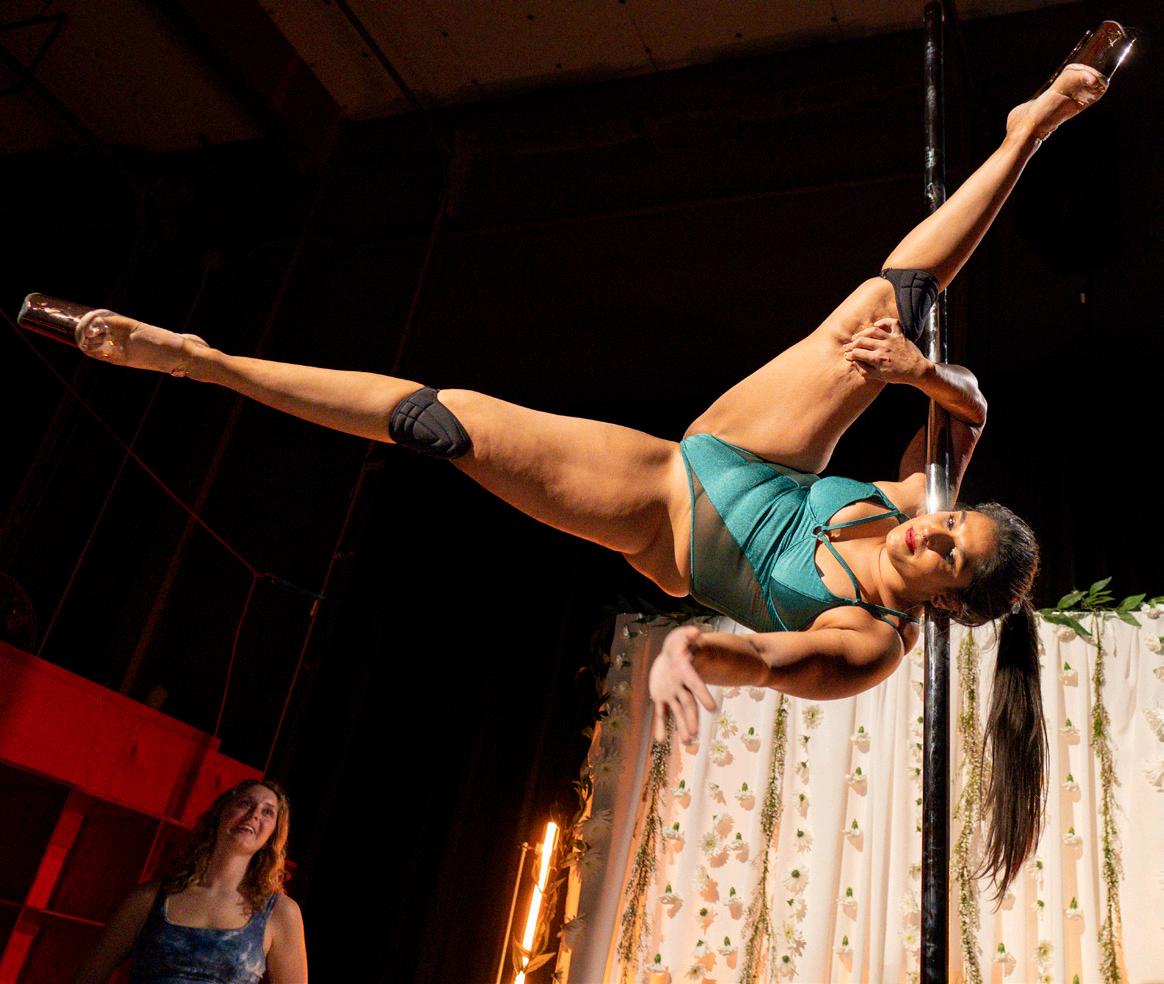
mental shift.”
The pole and belly dance community brings a vibrant energy to Rocknasium, and the pole showcase is an opportunity for them to show that Rocknasium is more than just a climbing gym.
“The way that we’re really able to take this [rock climbing] space and transform it to hold space for something that isn’t climbing, I think is really cool,” Latif said.
Serna appreciated the new angle that pole dancing brings to a rock climbing gym.
“It’s so much more than, ‘How long can I climb?’ or ‘How hard can I go?’ There’s an artistic aspect to these performances,” Serna said. “It’s not just about showing off strength but also showing off the meaning behind the movement: emotionally, mentally, sometimes physically.”
Sheena Cuccia, a UC Davis alum and belly dance teacher at Rocknasium, performed in the showcase, as did three of her belly dance students.
Her favorite part about being in the showcase was experiencing the range of acts that were included in the show.
Cuccia also commented on the crossover between rock climbing and dance.
“I really think that dance can play a big part in rock climbing, getting [in] that flow and in tune with your body,” Cuccia said. “I think it’s a crossover that people don’t quite expect, but that works really well together.”
Rocknasium’s pole dance show highlighted an underappreciated aspect of Rockniusm’s community, and everyone in attendance brought enthusiasm and appreciation to the event. Rocknasium’s pole and belly dance studio brings a lively community to the climbing gym, and the show’s production as well as the dancers’ hard work, made for an incredible show. Find information about future events or pole classes on their website, rocknasium.com, and look out for the recap video on their Instagram, @ rocknasium.
What is it like to be a commuter at UC Davis?
Students share their experiences as commuters
BY SABRINA FIGUEROA features@theaggie.orgRunning late due to packed parking garages and sleeping in your car during gaps in your schedule are just some of the many experiences in commuter culture.
On an average weekday, 30% of UC Davis commuters drive, 19% ride the bus and 1% ride the Amtrak, according to a survey conducted by UC Davis. The commuter population is bigger than most would think, as 85% of people who attend, work or visit the university travel from somewhere off-campus.
Commuting may be a viable or efficient option for those who live close to campus — such as in surrounding cities like Sacramento or Woodland — and don’t want to fully move to the city of Davis. Or, it can simply be more affordable for students and faculty compared to living in oncampus housing or housing in the area.
Braden Lee, a second-year mechanical engineering major, said that the major benefit of commuting comes from affordability.
“I lived in Davis for my first year, and I haven’t really considered it again afterwards,” Lee said. “A pro of commuting to Davis is that living expenses are much cheaper than if you were to live in town. But the bad thing about that is that it takes longer to come in and out of campus.”
As more people use their cars to get to school, the traffic in the area increases, potentially causing students to run late to class or even cost them their precious gas — which is not only expensive in California but also hurts the pockets of broke college students.
Commuters tend to have to plan their schedules accordingly and ahead of time in order to keep themselves on track, according to third-year biochemistry and molecular biology major Cynthia Ayala.
“I have to plan out my schedule ahead of time,” Ayala said. “Say I
have a class at like 4 p.m., I have to get ready at 2 p.m. to leave by 3 p.m., just in case there’s traffic or I need to find the hall or something. It’s an even bigger hassle when a class is at 8 a.m. and you have no other option.”
Apart from the scheduling situation, commuters face a more serious problem in the potential for feelings of isolation from other students and a lack of school spirit. In other words, sometimes commuting takes away from the average “college experience that grants some reinvention, social life and freedom,” according to David Tzall, a licensed psychologist, in an interview with Her Campus.
“Building a social network and feeling connected to the college community can be more challenging [for commuter students] because they don’t live in the same space with their friends,” Tzall said.
Tzall also noted that commuter students can experience mental health issues because of their off-campus status.
“[Commuting students’ mental health] can certainly be impacted in a different way [than non-commuters’], but it can still be impacted nonetheless,” Tzall said. “A commuter student might feel more disengaged or isolated compared to those living on campus.”
Imran recalled how she feels excluded living off-campus.
“Times where I don’t feel included are just in general,” Imran said. “A lot of people made friends in their dorms and whatnot, and I feel like I missed the opportunity entirely; that part was easy to see during [freshman] orientation especially.”
Lee described how living offcampus has impacted his time at UC Davis.
“It’s hard to make new friends,” Lee said. “Many of the friends I have already made were because of the time I lived on campus my freshman year. I usually feel included in the student environment the most when
The goal of the campaign was to generate words and poems from students that will appear in a mural on campus in fall 2024
BY BENJAMIN CARRILLO campus@theaggie.orgThe UC Davis Sheepmowers — an organization whose purpose is to raise awareness about alternative energy sources for cutting grass — ran a campaign throughout April where students could write words that remind them of climate change to form a word cloud. This climate poetry event would then inspire a mural that the Sheepmowers hope to create by fall 2024.
Abby Sanders, a third-year community and regional development major, is a research assistant for the
Sheepmowers and spoke on why climate poetry was the inspiration for the event.
“Campus is going through a big shift right now with green energy,” Sanders said. “The Sheepmowers are a big part of that, being a big thing on campus that people will visit and [will] raise awareness to this [topic].” Haven Kiers, a UC Davis associate professor in the Department of Landscape Architecture and the founder of the Sheepmowers, said that the organization began as an experiment to see how sheep compete against lawn mowers. “This started when I read about other countries using [sheep] as
substitutes for lawn mowers,” Kiers said. “I thought this was a really cool way of being sustainable and thought more about how we’re an agriculture school, and we have sheep. Why not use the sheep we have and see how they are at mowing lawns?” Kiers continued on about the fundamental principles of the Sheepmowers.
“We found that students’ mental health has been better with the sheep,” Kiers said. “Overall, just having the sheep creates an atmosphere that’s more positive [on campus].”
The sheep also do a great job at keeping the lawn shorter, according to Kiers.
“[We are] trying to highlight the invisibility of who’s doing the labor, and seeing the sheep as mowers is really interesting,” Kiers said. “[It starts] a conversation about the aesthetic and sustainability of the sheep as opposed to a typical lawn mower.”
The word cloud campaign aimed to inspire poems and ultimately a mural that will go up in the Sheepmowers’ honor.
“It started with crowdsourcing to come up with the words,” Kiers said.
“We asked students and local Davis schools to say what words they think of when they think of climate change.” Then, the Sheepmowers spraypainted the sheep with those words
I participate in clubs. That’s the only way I’ve been able to make new friends.”
A big part of commuting from offcampus or outside of Davis is also the fact that disconnection from students means feeling like you’re in isolation, according to Ayala.
“Honestly, I spend the majority of my time by myself, which isn’t necessarily bad because a lot of people struggle to enjoy their own company, and it was definitely something I had to learn how to do, but it still gets super lonely,” Ayala said. “It’s scary to think that my college years will be spent mostly alone, but sometimes you just have to make that sacrifice to get an expensive education.”
Imran shared that the aspect of feeling disconnected and isolated from her UC Davis peers impacts the way she tries to get involved on campus and make long-lasting friendships.
“As a commuter, I definitely feel like I need to overcompensate when it comes to being friendly at events and making an effort to talk or join leadership programs or clubs,” Imran said.
Although commuting can have both positive and negative effects on the individual, these students can always find ways to feel less isolated.
“I think it’s still so important to not get discouraged or reject people who might want to be friends with you during classes. Basically, don’t be bitter,” Ayala said. “Join clubs, talk to random people when you feel comfortable, stay on campus for as long as your body allows, be kind and keep an open mind.”
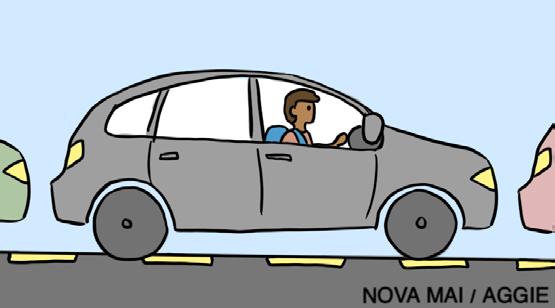
and allowed them to roam freely in a fenced-off area on campus from April 24 to 26.
“Based on where the sheep [were] standing, you’d write a poem,” Kiers said. “At the end, we’d create some sort of publication of the poems and then a mural with the most moving and inspiring poems and words.”
Kiers also discussed the goals beyond just the mural and what she envisions for Sheepmowers’ future.
“Because [we will eventually have] our own sheep, I’d love to eventually go to high schools, parks and events and just bring this show on the road,” Kiers said. “The idea is that we will eventually partner with the Green Care Lab to get our own sheep and to travel all around California with them to show off our purpose and raise awareness about alternative energy systems as a whole.”
The entire Sheepmowers organization strongly urges students to come visit the sheep whenever they see them around campus. They can typically be found grazing on grassy fields throughout campus.
Transit providers pose a threat to internet privacy and can cause serious cybersecurity issues
BY ARYAMAN BHATIA science@theaggie.orgResearchers at UC Davis have published a paper explaining how autocracies control the internet through transit providers, which are largely unknown to the public.
“Recent years have seen an increase in governmental interference in digital communication,” the study reads. “Most research on this topic has focused on the application level, studying how content is manipulated or removed on websites, blogs or social media. However, in order for governments to obtain and maintain
Majdi shared that he felt time stopped for him the day his son died.
“Time stopped for me on April 29, but the days kept moving and with them, as expected, many of the people we know moved on and expected me to follow,” Majdi said. “It’s like time wants to push me forward with the least disruptions to the space-timecontinuum [...] After all, how can time stop, if life goes on?”
He also shared that he knows they are not alone in remembering Karim.
“To me, April 29 is not a space-time anomaly that will fade in another year or two when normal wins and life goes on,” Majdi said. “To me, April 29 should be a new start. And I know we’re not alone in this. Your presence here with us tonight is proof that we’re not alone.”
Majdi spoke about the kind of person Karim was and the difference that he made.
“Karim is a mind that luminated brilliance and a heart that spread positivity and hope,” Majdi Abou Najm said. “A bundle of energy. I never heard him say, ‘I’m tired.’ And [Karim was] a time bender; he challenged time and did so much with his short journey through our physical world.
Finally, Majdi shared his wish for the community.
“Never take love for granted,” Majdi said. “I ask that you please reflect on this past year. Try to count how many times you said ‘I love you’ in this last year.”
“I came from a town with a lot of people that I shared my ethnic background with,” Arlene Cisneros, a third-year psychology and human development double major and the group’s academic chair, said. “Not that there aren’t people here that do. I just immediately felt that this is a new place for me, a new city. I had never moved away. I knew I wanted to find community, and Danzantes Del Alma has been that for me.”
The group has served as a home away from home for many students. As Cisneros put it, “Everyone has a genuine interest in supporting one another, whether that’s in the dance studio or personally or academically.”
Along with providing an outlet to current students, Danzantes Del Alma has also played a role in prospective students’ decision to attend UC Davis.
“I know many people whose decision to come to Davis was because we had an established folklórico group,” Mendoza said.
While the club is a tight-knit community, one of their goals is to highlight and celebrate the diversity within the group.
“Each single region is different, but it plays such an important role in the traditions and culture,” Maya Medina, a fourth-year biological sciences and Chicano studies double major and the group’s show chair, said. “That’s so important to our group as well, all of the diversity, even within Mexico. It goes beyond what is most often portrayed.”
With the theme of this year’s show, “Celebraciones Del Alma,” the group hoped to emphasize the importance of taking time to appreciate celebrating with loved ones.
“We get so caught up in very valid important stuff — there’s work, there’s life, there’s school,” Mendoza said. “But with spring quarter and the theme of our show, I feel like it’s important to celebrate hanging with your loved ones, your friends, just enjoying the party of life.”
Danzantes Del Alma’s 45th annual show served as a testament to the profound impact that the group has had on its members.
As the group continues to showcase the beauty and diversity of Mexican culture to the wider UC Davis community, it’s clear that Danzantes Del Alma will continue to leave a lasting impact on its students for generations to come.
control of digital data flows, they need to secure access to the network infrastructure at the level of internet service providers.”
In non-autocratic states, people access content on the internet first through access providers, such as Comcast, and then to content sources, such as Facebook and Google. However, the internet in autocratic states must go through an intermediary, known as a transit provider, before people access content sources.
Alexander Gamero-Garrido, UC Davis assistant computer science professor, provides an explanation into how these transit providers are
We didn’t have a Sunset Fest this year, and for that I’d like to apologize to the students. We did fail. Hopefully, that’s improving for next year. It hasn’t been an easy year for students. We have seen the protests [on] campuses, and I want all the students to know that we have. I want students to know that we have brought those issues to the stakeholders on campuses.
ASUCD is the whole undergraduate body, but, you know, we have a smaller family, which is our employees, and I hope they feel appreciated. And what better way to do that than [through] their wages, because we know prices are going up. We hope these budget hearings reflect that ASUCD wouldn’t be here without its employees. We also need to respect them and give them their respect. We know the minimum wage is going up. I feel like ASUCD has a responsibility to [pay] higher than that, to respect our students.
Q : Let’s move forward and address the impeachments. I mean, undoubtedly it marked your tenure. How do you feel about them now that a few months have passed?
Ojeda: I do not owe an apology to the Senate. I don’t believe they owe me an apology. I feel like they said their piece. I feel like I wasn’t allowed to say my piece at the time. And when it comes to student government, it’s not functional. I hope future senators understand that it’s part of their role to make it functional, to create a good work environment. I aim to do that. This year, I couldn’t.
Q: What has having this role meant for you in your personal life?
Ojeda: There’s some times where you’re just walking and you look at the CoHo and you look at The Pantry or Unitrans, and you’re like, ‘Oh, I might have put my two cents there when I said this during this meeting.’ I wouldn’t say I cry, but definitely some tears come out when I see students happy with ASUCD services. I get to be the first ASUCD AB540 president, and that’s a big thing. And actually, sometimes I wish I wouldn’t have been the first, because it has come with its difficulties, and I hope and I pray I’m not the last AB540 student. I feel like AB540 students’ opinions are not on the high table there, and we saw it with Opportunity for All crashing the way it did.
Q: You know what’s next for you, do you? I mean, you’re not going to be president next year–
Ojeda: Thank God.
Q: –do you think you’ll still be somewhat associated with ASUCD?
Ojeda: Yeah, well, they say you can never run out of, just run away from, ASUCD. I hope that’s not true. I do need a break from the third floor [the home of ASUCD administrative offices]. I currently don’t have plans to stick around in any position in ASUCD.
Q: Is there something you want to say and get off your chest, for our readers to know?
Ojeda: I feel like during this time, please take care of your mental health. School, grades and all the other criteria [used] to rate us as professionals do not define you as a person. Please engage with ASUCD. We have Unitrans. You might have voted in the elections if you didn’t vote in fall elections. Elections might seem silly, but elected people like me, elected people like this year’s senators — If you want [things] to change, if you want to keep [them] the same, you know, you gotta keep an eye [on] the candidates.
“Besides art, play KDVS in the background as a way to plug in some of our units,” Aridin said. “To incorporate [The] Pantry and Basic Needs, put resources on the bus. These things will make it iconic. Think big, because this is something worth the investment.” The new legislation introduced was SB #84, which transfers $5,000 from the Entertainment Council to Black and Arab student organizations. These funds would be used for the Empowered Arab Sisterhood Banquet and Black Student Union’s end-of-year BBQ. Lastly, the table moved into an open forum where Kaadan asked what to do if an ASUCD worker had been wrongfully terminated for political beliefs. The 30-minute ASUCD lawyer was suggested. The past meeting minutes were approved, and the meeting adjourned
detrimental to internet privacy and decentralization.
“The first reason is that people don’t know about them,” GameroGarrido said. “They don’t have a contract with users. For example, if I told you the name Level 3, which is a pretty important transit provider in the United States, you wouldn’t probably know about them because they’re just not highly publicized.”
Gamero-Garrido also mentioned that this centralization of the internet leads to cybersecurity risks.
“It actually also creates a kind of risk to the country, because if a foreign adversary takes control of this transit network — let’s say that they
at 7:49 p.m.
That’s done on purpose as introductions that slowly build up to the hook are becoming obsolete — they don’t pay off.
The modern era of streaming has changed the role that traditional media and entertainment play in our lives. Not only that, but it’s changing traditional media intrinsically. Media culture is moving more rapidly than ever before, and it will only continue to morph as the trend cycle moves and technology develops. The meaning of art in and of itself is malleable and constantly changing, but we’re seeing it change in new ways as streaming opens up new possibilities.
New challenges breed creativity, so it’s true that artists are carving new spaces and innovating new ways to succeed. Streaming comes with many challenges, but many artists have been able to rise to them. The landscape is changing — not for the first time and certainly not for the last. It’s not a matter of resisting that change but of how we treat and preserve the sanctity of great art.
Disclaimer: The views and opinions expressed by individual columnists belong to the columnists alone and do not necessarily indicate the views and opinions held by The California Aggie.
Scientists at the “GigaFarm” also use sensors to monitor humidity, plant growth, light and temperature, as well as hydroponics to water the crops and a combination of compost and coconut fibers instead of soil.
Finally, there’s salicornia, a type of succulent plant that thrives in marshes and saline water. This unique plant can be used both as a source of biofuel and as food for consumption, which is a major step forward. As freshwater is becoming scarcer in our warming world, freshwater crops are likely to become expensive and unsustainable, allowing for salicornia and other saline-based crops to lead the way.
These and similar new agricultural technologies are something that we collectively need to focus on now that reversing climate change seems to be out of the question. A mere two years doesn’t give us enough time to realistically pass political reform on environmental issues. What we can do is put time and resources into developing new tech that will allow us to survive and thrive in a world that has passed “the point of no return.”
Don’t get me wrong — as a globally connected community, our primary goal should still be to do everything we can to stop irreversible climate change. However, given the unattainability of completely reversing our current emissions and energy usage by 2026, we must start critically considering alternative solutions to problems that will arise in the future. This includes sustainable agricultural practices that aim to make farming easier in a potentially inhospitable environment, as well as distribution systems to ensure food security for atrisk communities. Whatever path we choose to take, the time to act is now. It’s crucial that we continue researching, exploring and advocating for sustainable legislation, procedures and practices that can create a safety cushion for our future.
Disclaimer: The views and opinions expressed by individual columnists belong to the columnists alone and do not necessarily indicate the views and opinions
run a phishing campaign — and they obtain the administrative password of [the] network administrator, then they might be able to observe or disrupt the connection to the entire country,” Gamero-Garrido said.
Phishing is a deceptive cyberattack technique in which attackers impersonate legitimate entities to trick individuals into revealing sensitive information or performing actions that compromise security. By bringing out these statistics, the team hopes to bring changes in the centralization of the internet.
“We hope that revealing this information will exert some pressure on the governments that are really
queerphobia takes over, and her fears culminate in the dramatic confrontation between her and Jess in front of the entire wedding audience during her sister’s “vidai” to her in-laws. In front of all of them, she calls Jess a hypocrite and demands to know “how [she] could be respectful here with [her] lot” when she knows (or rather thinks) that Jess has been “kissing [her] daughter in broad daylight?” In what becomes the climactic comedic punchline of the scene, she says, “Get your lesbian feet out of my shoes!”
Pulling her mother away from further embarrassment, Jules clarifies that she isn’t a lesbian but that she and Jess were “fighting because [they] both fancied [their] coach.” She adds, “Anyways, being a lesbian is not that big of a deal.”
The two young women protagonists, despite their different backgrounds, signify with their “allyship” that their progressive views are that of the filmmaker. The film was originally supposed to have a sapphic love story between them, but due to fear of a negative reaction from the film’s Indian audience (as seen in other Indian sapphic films before then), the coach, Joe (Jonathan Rhys Meyers) was introduced as a beard (someone used by a queer person/people to have a queer relationship while presenting as heteronormative to the outside world), according to various rumors. Other than their trauma bonding, and the fact that he believed in her athletic ability when no one else would, there is no real chemistry between Jess and Joe, or even Jules — whereas we can see the chemistry between the two girls, especially through Jules’ mother’s eyes when she perceives them to be sapphic for each other.
There are many clear indications of Jess and Jules’ sapphism throughout the film: there is lots of “gay gazing” as Jules observes Jess playing football in the park; the two girls have a queer butch or tomboyish aesthetic, including bandanas, rejection of push-up bras and sportswear and we see the contrast when Jess is made to dress up for an event, or with Jules’ hyper-feminine mother.
The film is about women’s football, with shots inside the locker room of women changing with each other and in community. All of the shots of the players warming up and playing in their Adidas “trackies” have been the gay awakening for countless women who today recount the queer legacy of the film.
It is also strewn with various sapphic references, like mention of the queer tennis player Martina Navratilova, gay icon Melanie C aka Sporty Spice and usage of their music and the iconic Bollywood courtship song “Noorie” sung by a woman. Also, the fact that the film was directed by a woman brings a feminine gaze that adds to the sapphism of the film.
Recently, Knightly mentioned that she would love to see an actual lesbian sequel to the film, to which Chada has responded positively.
Although the film follows Jess and Jules going against their families (especially their mothers) to pursue football and then careers in professional football, to those who know the sapphic contexts and connotations of the film, or even without, the film is truly about the coming-of-age of these two women who defy gender, sexuality and cultural norms to make a place for themselves in the soccer world. You can find “Bend It Like Beckham” on Hulu and Disney+.
overtly [centralizing] the infrastructure of their countries, which is exposing them to risks,” Gamero-Garrido said. Gamerro-Garrido also stated methods to help internet users protect their privacy, including the use of Virtual Private Networks (VPNs) and proxy services, which are tools that enhance online privacy and security by encrypting internet connections and masking IP addresses.
“I think the impact on ordinary people’s lives can be enormous,” Gamero-Garrido said. “As computer scientists, we benefit a lot from the fact that our field is growing.”
yet often there’s a discrepancy between the ideals we choose and the actions that we take. When recognizing how we factor into this system, it may sometimes feel impossible for individuals to choose only the sustainable course of action. However, there’s one thing that we all can do — buy less, and thus participate less in the society-wide culture of overconsumption.
Reading regularly is also proven to strengthen our attention spans, which is a crucial skill to develop since the creation of various social media platforms. For example, TikTok and Instagram feature short video clips as people scroll through them. These 15-second to a minute clips have contributed greatly to a widespread decrease in the average attention span. Additionally, UC Davis students discussed the importance of practicing reading in order to gain writing skills, which are important for college students to develop early on in order to convey their ideas coherently and successfully complete rigorous writing requirements.
Olga Muys, a second-year history major, agreed that reading has helped her writing process.
“Learning to enjoy reading and engaging with texts from an early age has absolutely helped me academically, not just in terms of my reading comprehension abilities but also in terms of writing,” Muys said. “‘Brideshead Revisited’ by Evelyn Waugh is one of my favorite books because of how immersive its language and characters are, along with how it examines themes of beauty, sexuality and spirituality.”
Muys continued by giving advice about habitual reading, no matter the kind of material you choose to read.
“I’ve always believed that the best way to learn how to write is to just read as much as you can, especially when you’re young,” Muys said. “You absorb so much about vocabulary and argument and structure, purely through osmosis, even if you’re reading something non-academic.”
As these students have discussed, there are many reasons to pick up a book and immerse yourself into a new story every now and then. There’s no need to force yourself to read books that are considered literary classics, either; the importance of getting accustomed to habitual reading is the key.
Simply incorporating reading into your routine — even if it’s only for a couple of days each week — might just be a worthwhile investment in your cognitive development and academic performance.
reflects a lack of consideration for ethical labor. Cheap clothing may save consumers money, but the cost ends up paid by the workers in textile factories who sacrifice their time and their health producing fast fashion. On the other hand, cheap fast fashion is the most realistic clothing choice for many, who may not have the knowledge

UC Davis men’s baseball goes 0-3 against UC Santa Barbara over Picnic Day weekend
BY DIEGO CERNA sports@theaggie.orgOver the weekend of April 19 to 21, the UC Davis men’s baseball team hosted the UC Santa Barbara Gauchos in a three-game weekend series on the Phil Swimley Field at Dobbins Stadium. Coming off back-to-back wins against Abilene Christian University and University of the Pacific, the team looked to extend their winning streak against the Gauchos.
However, this would be a tough matchup, as UC Santa Barbara has been successful this season with an impressive conference record of 8-4 going into the series. The Aggies entered Picnic Day weekend with an overall record of 1717 hoping to climb up in Big West Standings.
The series kicked off with a defensive pitching masterclass from both starting pitchers on April 19. The first game featured UC Davis’ pitcher third-year Bryan Green who threw a spectacular game. Green pitched a no hitter in seven innings before giving up only one run. Nonetheless, he finished with an impressive nine person strikeout, arguably the best performance of his collegiate career. UC Santa Barbara’s talented pitcher third-year Ryan Gallagher also pitched a great game, providing a complete shut out. Gallagher currently has the thirdlowest earned run average (ERA) out of Big West pitchers at 2.49, showcasing his talent.
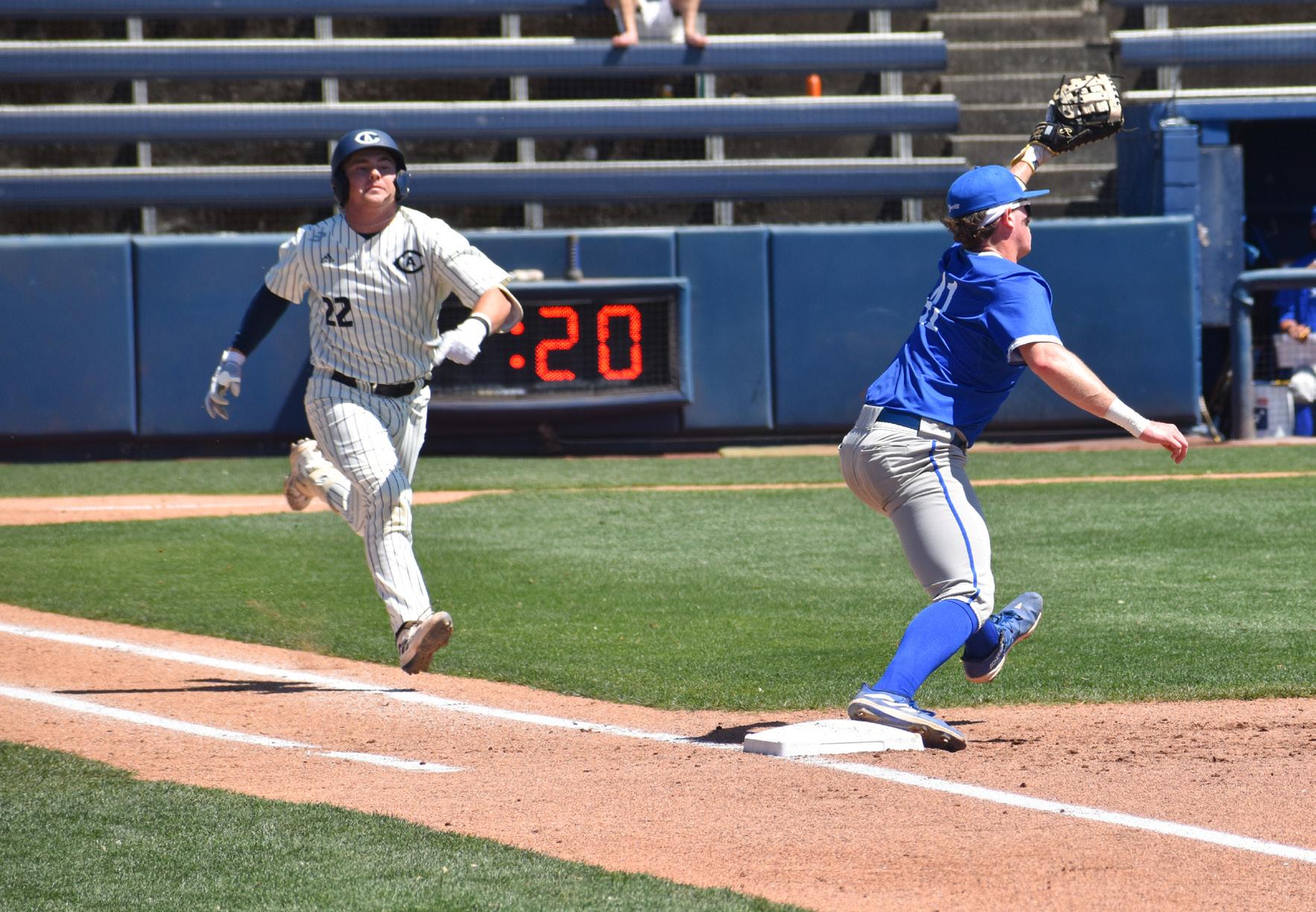
toward
The Aggies kept it a competitive game throughout, as they headed into the top of the eight down only 0-1. With great pitching from both sides, there were only two hits recorded from Davis and three hits recorded from Santa Barbara in total — that was, until Gaucho's first-year Jonathan Mendez
a
swing, putting the Aggies on the board. The Aggies lost to the
hit a home run in the eighth inning to extend the lead. After third-year Ivan Brethowr sealed the game with a home run in the ninth, the final score was 3-0, with the Gauchos victorious.
The second game took place on April 20, our 110th annual Picnic Day. The game offered free admission for
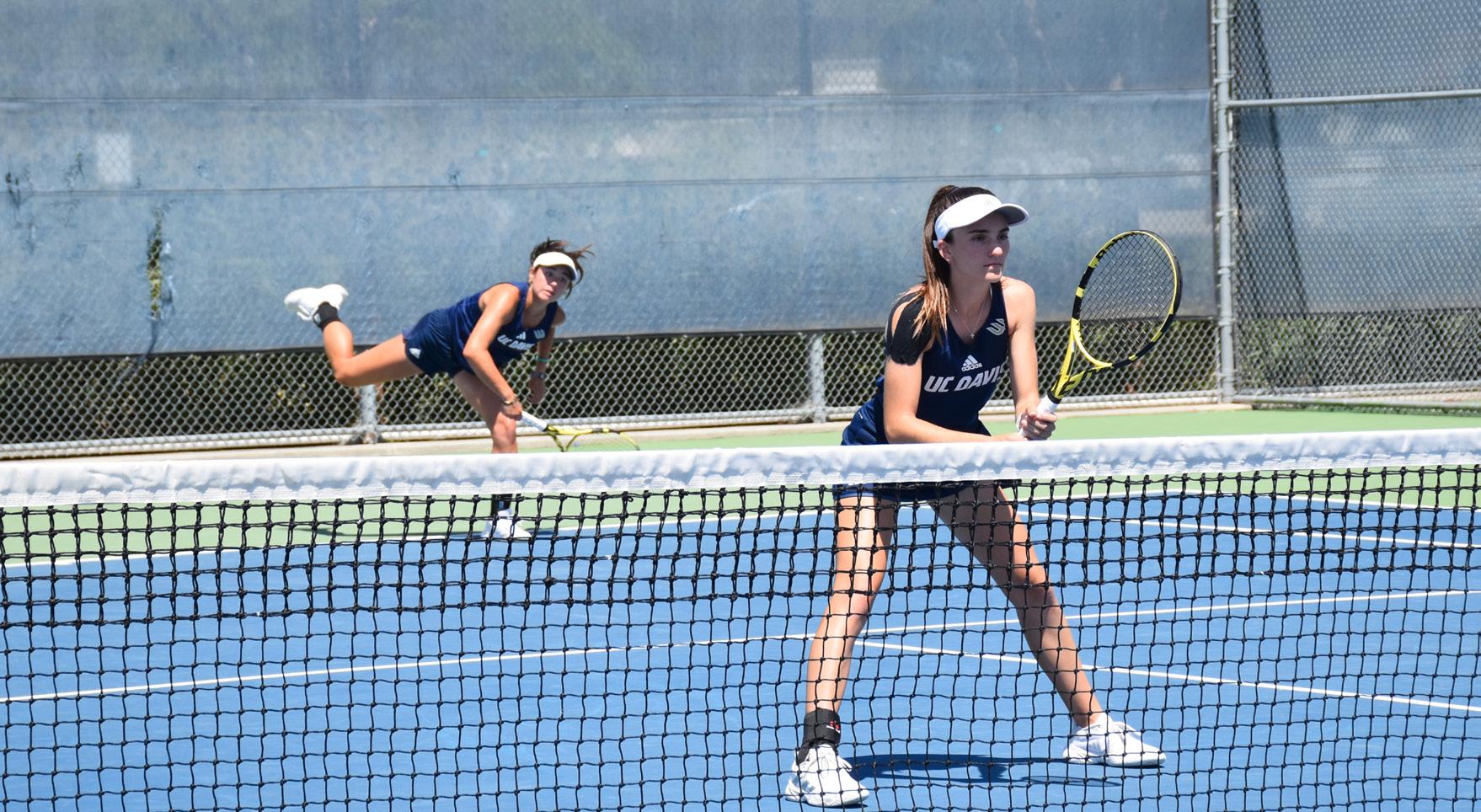
(Maia
BY EMMÍA J RIVERA sports@theaggie.orgAggie)
To conclude the regular season, the UC Davis women’s tennis team went out in winning fashion as they swept Sacramento State at the Marya Welch Tennis Center on April 19. Prior to the match, the Aggies pursued a threematch winning streak, beating CSUN, Stanislaus State and Portland State.
anyone to enjoy during all of the Picnic Day festivities. Unfortunately for the Aggies, the game was rough with Santa Barbara’s offensive firepower proving too much to handle.
Home runs by Santa Barbara’s thirdyear Aaron Parker, fourth-year Brendan Durphy, third-year Jessada Brown and
Brethowr left fans speechless. All four players are in the top 10 for most home runs in the Big West Conference, which showed with the 6-1 victory by the Gauchos. Despite the loss, third-year Aggie Braylon Woodridge connected on two out of his four at bats. Second-year Nick Heeley also achieved the Aggies’ only run in the sixth inning.
With one match to go, the series finale on April 21 saw the same result. Second-year Ryan Lee gave the Aggies an early lead providing a runs batted in (RBI) double up in the middle for a 1-0 lead. Lee also hit a single later on, going 2-4 for the day and for the benefit of the Aggies as the only time the Aggies would put points up.
UC Davis third-year Noel Valdez started for the Aggies, pitching five innings and allowing three runs, along with five strikeouts. Nick Leehay came away from the game with two walks. Santa Barbara’s second-year Tyler Bremme and first-year Cole Tybra threw 11 strikeouts to give the Aggies their third loss of the weekend. The final score was 4-1 in favor of the Gauchos. The Gauchos’ series win helped move them up to second place in Big West Conference standings, behind UC Irvine. The Aggies currently sit at eighth place and will look to climb the rankings before the Big West playoffs commence. They will face Conference opponents Cal Poly San Luis Obispo, Long Beach State, Cal State Fullerton, UC Riverside and Cal State Bakersfield in order to determine the rankings.
Amidst the hustle and bustle of Picnic Day, UC Davis women’s lacrosse took on Stanford in their final home match of the 2024 season. As crowds swarmed across the UC Davis campus and downtown Davis, many lacrosse fans made their way to the UC Davis Health Stadium to celebrate the program’s seven graduating seniors as they appeared in the last home game of their college careers.
conceded 20 or more goals, although they have also had some decisive victories themselves, including an upset win against UC Berkeley.
With the 21-8 victory, Stanford clinched the number one seed spot for the PAC-12 tournament, which kicks off on May 1 in Los Angeles. The Cardinals have an undefeated conference record, with six straight victories.
The Aggies will have to wait a little longer to determine their tournament position. Seeding will be finalized after their road game against the Arizona State Sun Devils on April 27. Currently, UC Davis sits at fourth in the league, with a conference record of two wins and four losses. Three other teams share this record, so the Aggies must win their final match against Arizona to be seeded high.
Following the first win, fourth-year and third-year sisters Olive and Daisy Maunupau came back from a 4-1 deficit to secure a point for Davis in a tiebreak set 7-6. Additionally, Olive Maunupau continued that streak into her singles match where she took a straight set victory in her last home match as an Aggie. Another strong performance came from second-year Kaia Wolfe, who won all of her sets after coming back from a mid-season injury. Additionally, first-
The first win of the day against Sac State occurred when fourth-year duo Carly Schwartzberg and Michelle Zelle won 6-4 against Mayya Gorbunova and Lou Baudouin of Sacramento State.
year Mika Ikemori won an impressive all-set victory against Sac State’s Gorbunova. This became Ikemori’s third consecutive straight singles win and concluded the triumphant celebration for the seniors
Overall, the fourth-years were successfully commemorated for their work on the courts and concluded the season victoriously heading into the Big West Championship tournament. In the coming weeks, we will see if Davis can do what it takes to win and bring home the trophy.
With very few games left in the regular season, both teams were looking for a strong start to lead them to victory. However, Stanford was the first to attack as they immediately took the upper hand, scoring nine unanswered goals in the first quarter. The Aggies fought back with two goals to end the first quarter and were able to open the scoring in the second quarter. While third-year Grace Gerbhardt had a stellar performance, ending the match with four goals, the Cardinals stepped up their own game.
Each time the Aggies scored, the Cardinals would respond with several goals of their own, never letting their lead fall below seven goals. The final score of the game was a tough 21-8. This is only the third match of the season in which the Aggies have
This will be the lacrosse team’s last season competing in the PAC-12. Starting in the 2024-2025 season, the Aggies will join the Big 12 Conference for its inaugural women’s lacrosse season.
While the team is looking forward to a new slate of opponents, their focus remains entirely on the culmination of the 2023-2024 season and making the most of their last PAC-12 Championship.
This year alone, two major sports gambling scandals have occurred, exposing an industry overtaken by gambling
BY CAROLYN (CARI) FENNsports@theaggie.org
On April 17, the NBA announced that they had placed a lifetime ban on Toronto Raptors two-way player Jontay Porter after he was found to have violated league betting rules on games. Porter is currently facing serious repercussions for providing information to sports gamblers and faking an illness for betting purposes. The NBA began investigating Porter in late March after multiple instances of betting irregularities were noticed. The league was mainly looking at prop bets involving Porter from games on Jan. 26 and March 20. When the Raptors played the LA Clippers on Jan. 26, Porter left the game after just four minutes due to an aggravation of an eye injury. Before the game, there was an increased betting interest in the under for Porter's props, with DraftKings Sportsbook stating that the under on Porter’s three-pointers was the biggest money winner for bettors of the night for the NBA.
Then, nearly two months later on March 26 when the Raptors faced the Sacramento Kings, Porter left after playing for just three minutes with an illness and did not return. The next day, DraftKings Sportsbook reported that Porter's Prop bets had the largest winnings of the night in the NBA. That night, it was later discovered that a bettor associated with Porter placed an $80,000 parlay proposition bet on Porter’s props hitting the under, which would have resulted in a $1.1 million payout. The unusual betting activity caused the $80,000 bet to be frozen and never paid out.
Suspicion largely began to arise following the March 20 game after licensed sports betting operators and an organization that monitors legal betting markets brought the findings of these suspicious bets to the NBA.
The suspicious increase in the number of bets on the under of Porter's props and the unusual performance of Porter led to the two-way player's downfall. In the end, the NBA found that Porter had violated league rules on sports betting. Along with being
found guilty of disclosing confidential information to a sports bettor for the March 20 game, Porter was found to have placed bets on NBA teams from January through March 2024. While Porter was traveling with the Raptors’ NBA G League affiliate, Porter placed at least 13 bets on NBA games on an associate’s betting account ranging from $15 to $22,000. Porter bet a total of $54,094 and earned a payout of $76,059 during those two months.
The league's investigation into Porter remains open and may result in further findings. Porter could potentially face criminal charges for his actions.
The last time the NBA faced such a large gambling scandal was in 2007 when referee Tim Donaghy pleaded guilty to two felonies for betting on the NBA and advising professional gamblers.
While Jontay Porter is the first player in almost 60 years to be banned from the NBA for gambling offenses, his scandal is not the first huge sports betting scandal to rock the sports world in 2024.
On March 20, 2024, the Dodgers
fired Shohei Ohtani’s interpreter, Ippei Mizuhara, after questions started to arise following nearly $4.5 million in wire transfers from Shohei Ohtani’s bank account were sent to a bookmaking operation. At first, Mizuhara tried to claim that Ohtani had sent the money to pay off his gambling debts for him.
“[Mizuhara] has been stealing money from my account and has been telling lies,” Ohtani said after he and his lawyers came out to deny Mizuhara’s claim.
While the MLB initially opened an investigation into Ohtani to see if the superstar had engaged in any form of sports betting with his former interpreter, they have since announced that they will wait for the conclusion of the federal government's case against Ippei Mizuhara before deciding if further investigation is necessary. The scandal comes after Ohtani signed a record-breaking $700 million deal with the Dodgers in December — the terms included Ohtani being able to keep his interpreter Mizuhara. Despite gambling once being greatly restricted in professional and high-level
college sports, it has been drastically increasing in the last few years. In 2023 alone, Americans bet $120 billion on sports, which is about a 28% increase from the year before. Sports betting has taken off greatly since the U.S. Supreme Court struck down a federal law that prohibited it in 2018. As a result of the ruling, sports betting has been made legal and operational in 38 states, including Washington, D.C., through online/ mobile sportsbooks. While these two betting scandals have rocked the sports world this year, they are not the first and certainly will not be the last. These scandals are likely only the tip of the iceberg of betting scandals within the sports world as our world progresses to more technologically advanced generations.
